A Brief History of the Sibley College and School
A Brief History of The Sibley College and School of Mechanical Engineering at Cornell: Including the Graduate School of Aeronautical Engineering and The Department of Theoretical and Applied Mechanics.
By: Francis C. Moon
Joseph C Ford Professor of Mechanical Engineering Emeritus
ASME Engineer Historian 2011
Draft: January 15, 2015
If you would like access to a full PDF version of this history, request one at mae-communications@cornell.edu
Preface
Interest in the history of mechanical engineering began for me during my tenure as Chair of T&AM (1980-1987) when I came across a book "The Mechanical Engineer in America: 1830 - 1910", written by a Smithsonian historian, Monte A. Calvert in 1967. It contained a Chapter on the Sibley College of Mechanic Arts at Cornell and the conflict between the proponents of a 'shop culture' and an 'academic or school culture' in the teaching of mechanical engineering. This debate was resolved with the arrival of Professor Robert Thurston from Steven's Institute of Technology who was the first president of the ASME. Later I discovered a set of three 1890's volumes of the Sibley Journal of Engineering at The Bookery, our local rare books store, and was fascinated with the dynamic academic life of the early College of Mechanical Engineering.
In the course of my research into Cornell's historic Reuleaux Collection of kinematic models and through my travels in Europe and Germany, circa 2001, I discovered how wide the reputation of Cornell's Sibley College was a century ago. With the coming celebration of Cornell's sesquicentennial in 2015 it dawned on me that my generation of retired professors had lived one third of Cornell's history. With the encouragement and support of Prof Robert Cooke's oral history project, I began to record interviews with more than a dozen senior and retired faculty in the Sibley School and T&AM. I further concluded that I would attempt to begin a written history of mechanical engineering at Cornell including the Sibley College and the evolving Schools of Mechanical and Aerospace Engineering, the Graduate School of Aeronautical Engineering (merged in 1972) and the Department of Theoretical and Applied Mechanics (merged in 2008).
This first short essay is but a thumbnail sketch of the Sibley College history. For me it was my first attempt at learning the names and biographies of the principal characters in the plot and politics of creating what was, a century ago, one of the top mechanical engineering colleges in the United States.
There are parallels in the Sibley School between 1904 and 2014. In 1904 there was a large change in teaching personnel with the sudden death of Thurston in 1903. One of the star professors, William Durand, was wooed by Stanford University. New technologies such as the automobile and the airplane would change the curriculum. And energy prime movers had changed from steam piston engines to internal combustion and turbine driven electric generation. Electrical engineering, part of the Sibley College because of its' connection to power generation, saw the coming of radio electronics and in 1920 separated into its own school in the College of Engineering.
For those who might review or read this manuscript I would be most appreciative of advice and criticism. I am grateful to Frank Moore for his history of the Graduate School of Aeronautical Engineering as well as Thomas Avedisian for a similar essay. Jack Booker also contributed a timeline and names of faculty in the School in the 1950's. John Callister sent me his notes on the Land Gant Act of 1862. Thanks are also due to Ms. Alice 'Toni' Anthony for her interview about her days as head administrative secretary of the Aero School and the Sibley School. Elaine Engst the University Archivist has also been helpful in my research.
Francis Moon, January 15, 2015
Table of Contents
Introduction: p3
- Shop Culture vs School Culture: p3
- Creation of a Unified College of Engineering: p4
Sibley College- The Big Themes in Teaching and Research: p11
- Basic Components of the Education of a Mechanical Engineer: p11
- Technical Areas in the Sibley College in the First 50 Years: p13
Aeronautical Engineering in the Sibley School: p15
Sibley College Museums and Collections: p19
- Reuleaux Collection: p19
- Morse-Vail Telegraph Recorder of 1842: p22
References and Sources: p27
Appendix I: Deans and Directors of the Sibley College and School: p29
Appendix II: Chairs of the Department of Theoretical and Applied Mechanics: p31
Appendix III: Faculty and Alumni Members of National Academy of Engineering: p32
Appendix IV: Oral History Project of the Sibley School: p34
Appendix V: Sampler of Short Bios of Selected Sibley Faculty and Graduates: p35
- Robert H. Thurston: p35
- Hiram Sibley: p37
- Maxwell Upson: p38
- Rolla C. Carpenter: p39
- Hermon A. MacNeil: p41
- John E. Sweet: p43
- John L. Morris: p44
- Dexter S. Kimball: p45
- William F. Durand: p47
- Leroy Grumman: p49
- Albert W. Smith: p50
- Kate Gleason: p51
- Clarence W. Spicer: p51
- Lionel S. Marks: p52
- J. Norman Goodier: p53
- William R. Sears: p55
- Wanda Szemplinska-Stupnicka: p57
- G. David Low: p57
Introduction
With the approaching Sesquicentennial (at the time of writing) of the founding of Cornell University, it is appropriate to review the history of the founding colleges and departments of Cornell. The University obtained its charter in 1865 under the Morrill Land Grant Act of 1863. This act required the new university to offer courses in agriculture and the 'mechanic arts'. Two of the original colleges were the College of Mathematics and Engineering, and the College of Mechanic Arts. The former was quickly separated into the College of Civil Engineering and the Department of Mathematics. These colleges opened their doors to students in 1868.
In 1870, Hiram Sibley a business partner of Ezra Cornell and a founding investor in the Western Union Telegraph Co. donated money to construct a separate building for mechanic arts. This structure is now West Sibley Hall to the left of the Dome on the North Campus. The name was changed to the Sibley College of the Mechanic Arts. Its dean was Professor John Morris, educated at Union College in civil engineering. Mechanical engineering was a new field and in 1873-4 a Bachelor of Mechanical Engineering was offered in a four-year curriculum.
Sibley not only gave money to build buildings for mechanical engineering but he and his son gave money for an endowment, equipment and collections including $8000 [in 1880 dollars] for the Reuleaux kinematic models. His son Hiram W. Sibley later bought and donated to the Sibley College Museum [not the University] the Morse-Vail receiver used in the historic telegraph demonstration in 1842 between Baltimore and Washington DC.
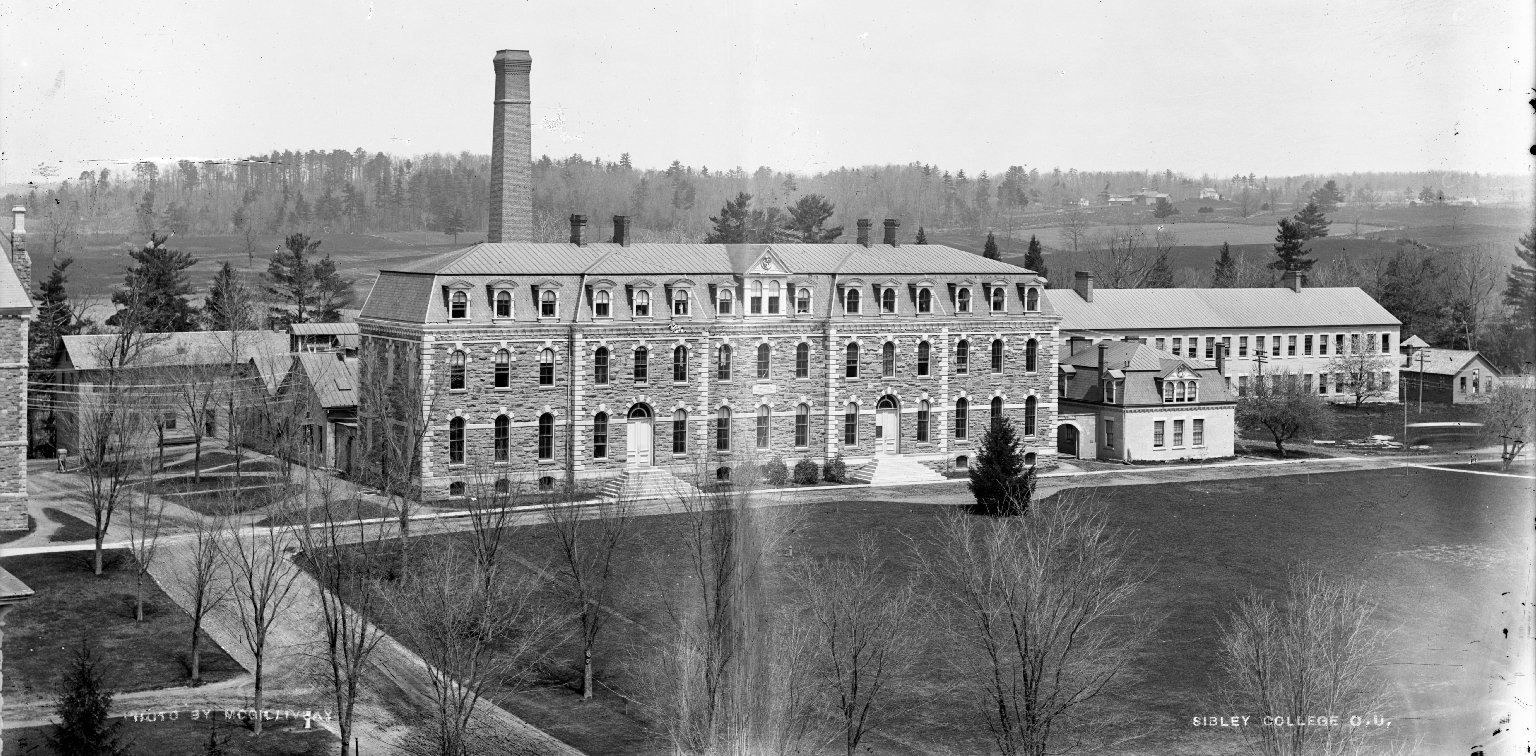
Shop Culture versus School Culture and Robert Thurston
In 1885, Cornell’s first president Andrew Dickson White, a historian and world traveler and ambassador, convinced nationally known engineer Professor Robert H. Thurston to leave Steven’s Institute of Technology and come to Cornell. Thurston had taught at the US Naval Academy and was a world expert in steam engineering, thermodynamics and materials of engineering. He had translated Carnot’s work in thermodynamics, and had discovered work hardening of materials with his famous ‘autographic testing machine’ that sits in the MAE sophomore strength of materials laboratory. Thurston was also the first president of ASME in 1880. Thurston had also written one of the first books in bio-engineering attempting to apply thermodynamics to animal systems.
With the arrival of Thurston in 1885, the name was changed to the Sibley College of Mechanical Engineering and the Mechanic Arts. He raised the entrance requirements but kept a balance of engineering science and practical training. He also pioneered the use of engineering laboratories as an integral part of a BS ME degree. His educational philosophy first practiced at Steven’s Tech, embodied a balance between mechanical skills, mathematics and physical science as well as engineering laboratory experience. Now called the engineering science approach, Thurston resolved the tension in the early years between the so-called ‘shop culture’ of John Sweet and the ‘school culture’ of Union College civil engineering trained John Morris. This debate raged between students, alumni and Trustees in the years before Thurston’s arrival. [See Calvert, 1967]
In spite of higher entrance requirements, enrollments soared during Thurston’s tenure and Sibley College was even a cover story in Scientific American magazine.
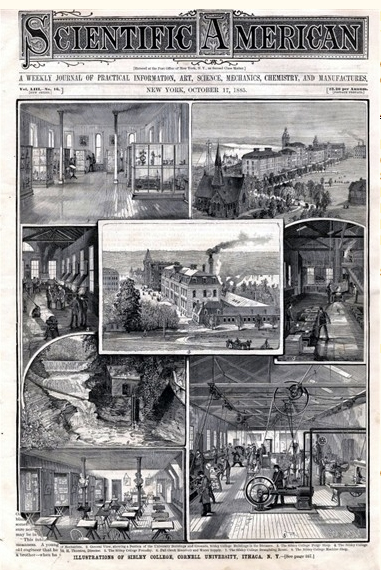
Thurston started the College journal called the “Crank” in 1885 and later changed the name to the Sibley Journal of Engineering, which had a half-century history from 1885-1935.
Thurston died unexpectedly in 1903 and Professor Albert Smith became dean. Smith served from 1904-1922. Electrical engineering was part of the Sibley College from 1885 until 1919. Cornell claims the first department of electrical engineering in the United States as well as the first electric lighting systems on campus. The original Gramme dynamo direct current generator is in the Physics teaching lab in Rockefeller Hall. There were also studies in naval architecture and engineering.
In the 1913-14 Announcement of the Sibley College of Mechanical Engineering and the Mechanic Arts there are listed the following departments:
- Department of Mechanics of Engineering
- Department of Machine Design and Construction
- Department of Experimental Engineering
- Department of Power Engineering
- Department of Electrical Engineering
- Department of Engineering Research
It should be noted that there were courses in the 1913-14 catalog called “Mechanics of Engineering” as well as “Engineering Mathematics” similar to MAE 2020 and ENGR 2930-2940.
The graph below shows the rapid increase in enrollments in the college during Thurston’s reign. The dip is attributed to his increasing the entrance requirements by requiring more math and science as well as liberal arts in high school.
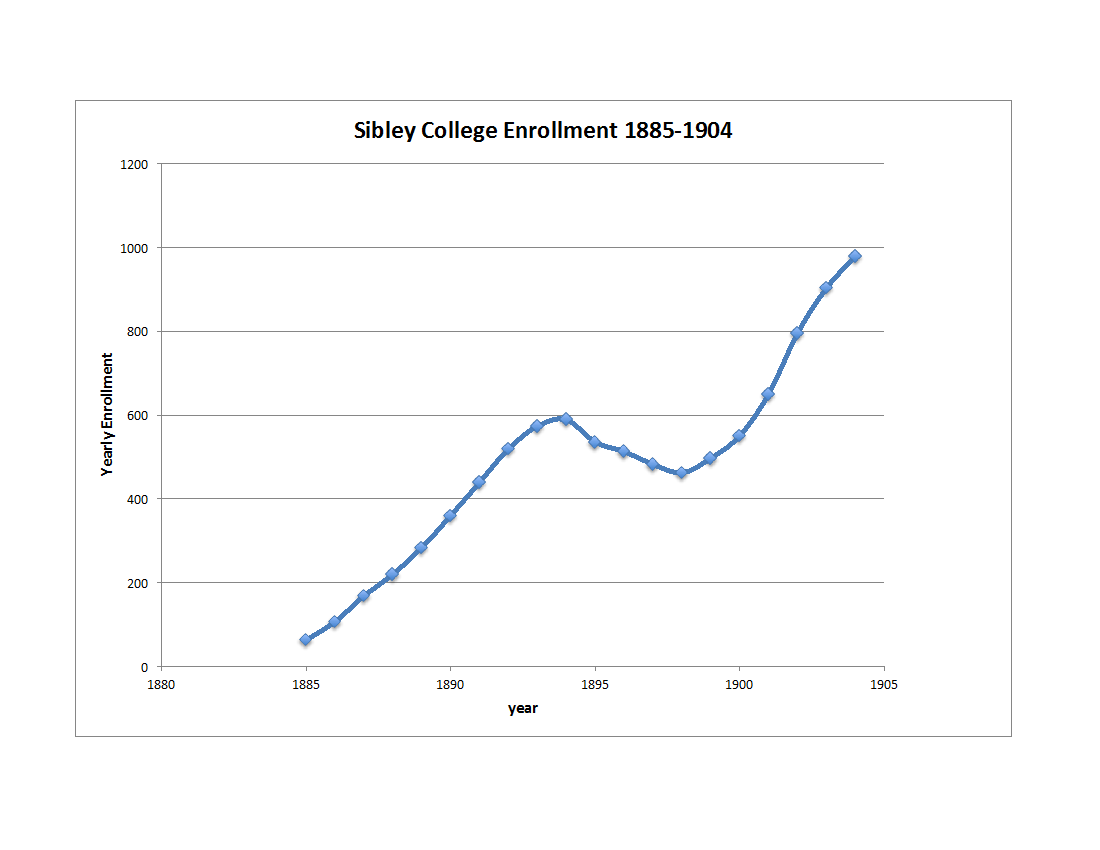
Creation of the Unified College of Engineering
In 1919, the Trustees decided to create a unified College of Engineering under Dean Dexter Kimball of the Sibley College. The original two ‘colleges’ were renamed and electrical engineering spun off on its own:
School of Civil Engineering
School of Electrical Engineering
Sibley School of Mechanical Engineering
These names survived until the 1970’s.
Industrial Engineering and the Birth of ORIE
In the 1913-14 catalog there is a course in ‘industrial organization’ taught by Dexter Kimball. This later developed into a Department of Administrative Engineering within the Sibley College. In 1961, this department was spun off from Sibley into an independent Department of Industrial Engineering and Administration. The department later changed its name into Operations Research and Industrial Engineering that today is Operations Research and Information Engineering or ORIE.
Aeronautical Engineering
In the early days of human flight, Cornell students formed a Cornell Soaring Club in 1910. This group, like our Sibley teams today, built a fully operational glider and held competitions with other Ivy colleges in the Northeast. A headline from a popular magazine in 1913 is shown below announcing a four-minute flight in a Thomas biplane.
In the late teens, the US Army established an aviation ground school at Cornell.
During the 1930’s the faculty offered a senior option in Aeronautics. This involved a junior course in aerodynamics and a fourth year course in airplane design. During this time Sibley Professor Karl D Wood had written a book on airplane design. According to the Director H Diedericks in 1935, Cornell was discouraged from creating a more extended program by the Guggenheim Foundation who was already supporting aeronautical engineering at six other institutions.
After the Second World War ended in 1945, and the new nuclear, cold war era began, Cornell established a separate Graduate School of Aeronautical Engineering or GSAE under Professor William R. Sears, a former student of Theodore von Karman at Cal Tech. It had an unofficial relationship with the newly created Cornell Aeronautical Laboratories in Buffalo, a gift from the Curtiss-Wright Corporation. In the mid-1960’s Bill Sears shifted his interest to the new Applied Mathematics Center and Professor Edwin Resler took over as Director of GSAE. By the early 1970’s with the end of the Vietnam War and the end of the NASA Moon missions, support for research in GSAE fell. In 1972, the department was merged into the Sibley School under the director Edwin Resler. The name was changed into Sibley School of Mechanical and Aerospace Engineering.

Theoretical and Applied Mechanics
There were always courses taught in the College and School in engineering mechanics. In 1913 there was a separate department of "Mechanics of Engineering". This department existed into the 1940's. The principal star of mechanics in the Sibley School was James Norman Goodier [1905-1969]. Goodier had studied at Cambridge and then came to the University of Michigan to study the theory of elasticity under the Ukrainian master Stephen P Timoshenko. Goodier came to the Sibley School in 1938 as Professor of Applied Mechanics. Unfortunately after WWII he left for Stanford in 1947. One of his students at Cornell was George Carrier who later became a distinguished professor at Harvard.
In the late 1940's with the rise of the importance of mathematical methods in engineering, the College of Engineering created a graduate Department of Engineering Mechanics from faculty in mechanical and civil engineering designed to prevent duplication of courses in mechanics. This department then became the Department of Engineering Mechanics and Materials under Professor Gundar originally on the faculty of the Sibley School. By 1960 this department had undergone mitosis into the Department of Theoretical and Applied Mechanics under Professor Edmund Cranch who would become Dean of Engineering and later president of Worcester Polytechnique Institute. Engineering materials then evolved into Materials Science and Engineering. T&AM had a successful existence of a half-century as a separate graduate department attracting excellent students as well as government supported research. Mechanics related students and faculty also produced eight elected members of the National Academy of Engineering from 1965-2000.
In 2009, the Provost merged the graduate Department of Theoretical and Applied Mechanics back into the Sibley School after a half century of independence. There was some discussion about a name change but the enlarged School has retained the name Sibley School of Mechanical and Aerospace Engineering.
Biomechanics and Biomedical Engineering
As the last example of the Sibley School as a parent to other College of Engineering departments we cite the recent department of Bio-medical Engineering. In 1969 Professor Don Bartel joined the Sibley School in the Design Department under Professor John MacManus. He first conducted joint research in the Vet College but later developed a research program with the Cornell Hospital for Special Surgery (HSS). This program developed into both an educational and research unit of the Sibley School with participation of the late Professor Dean Taylor and Jack Booker. Since the 1990's the School has tried to assign four faculty positions to biomechanics.
However in the last decade one bio-mechanics faculty was drawn again to a west coast university, [not Stanford this time] another became part of a new Cornell graduate department of Bio-Medical Engineering department and the founding member of the group Donald Bartel retired. Also in 2013 the College of Engineering decided to let Bio-Medical Engineering offer an undergraduate program and a senior faculty member from MAE biomechanics was elected Chair of this new department.
This example follows the past pattern in the Sibley School in which advanced research and teaching groups are spun off into separate departments of the College of Engineering.
In summary the Sibley College and School of Mechanical Engineering has spawned the following departments;
Electrical and Computer Engineering
Industrial Engineering now ORIE
Theoretical and Applied Mechanics
Material Science and Engineering
Bio-Medical Engineering
It should be mentioned that the Sibley School was not the sole donor to new departments. For example Physics contributed to Electrical Engineering, Industrial Engineering had faculty from both Chemical Engineering as well as Sibley. Materials Science was created from parts of both Engineering Mechanics and Materials [T&AM] and the metallurgy faculty of Chemical Engineering. T&AM was created with faculty from both Sibley and Civil Engineering. Chemical Engineering also contributed to the new Bio Medical Engineering department.
The creation of Applied and Engineering Physics is another complicated story. There was a close cooperation between the Graduate School Aeronautical Engineering and Engineering Physics faculties but that will wait until a full text history.
Sibley College- The Big Themes in Teaching and Research
Defining Mechanical Engineering in the 19th Century in the US
The first large theme for Cornell engineering in the 19th c. was the creation of an educational program in mechanical engineering distinct from the idea of training in the mechanic arts.
In the first half of the 19th century there were established "Mechanics Institutes" that taught young men the business of creating, operating and servicing machines. These institutes initially arose in the UK as a way to supplement the apprentice system and to spread knowledge about the new field of steam power and related fields of transportation and manufacturing. In the US there were Mechanics Institutes in San Francisco, Boston, New York City and also in neighboring Rochester, NY.
According to the memoirs of President AD White, the Cornell founders had no idea what 'mechanic arts' meant in a university. And most other newly created Land Grant universities didn't either. Ezra Cornell had the idea of young men producing products for sale that might help fund the university. However Andrew D White in his wisdom saw that this was the wrong path. He along with John Morris, Hiram Sibley and John Sweet saw the College as training students in the knowledge, but not the skills of, machining and manufacturing methods. Graduates would then become designers, supervisors, managers and entrepreneurs in the mechanical enterprises of the nation; they would lead through hands-on knowledge, but with a wider educational background than a shop foreman or foundry worker. This idea was later refined by Robert Thurston to include a larger understanding of mathematics and physical science. In fact, although the original name of the College in 1870 was 'Mechanic Arts', the university degree was labeled 'mechanical engineer'.
By the end of the 19th century Cornell was producing nearly one in five mechanical engineers in the US, its graduates were early leaders in the ASME and in many industrial firms and other emerging university programs in the country were patterned after the Sibley model. This leadership in engineering education is recognized in Calvert's "History of Mechanical Engineering" with an entire chapter devoted to Cornell's Sibley College. In the Henry Ford Museum in Dearborn MI, there is an exhibit on the emergence of mechanical engineering featuring a photo and description of Cornell's Sibley College. The Sibley College was also the front-page cover story on an 1885 issue of Scientific American. Robert Thurston's writings on engineering education were translated into German and read by the great German engineer Professor Franz Reuleaux in Berlin.
Basic Components of the Education of a Mechanical Engineer
Many of the early Land Grant universities struggled to define "mechanic arts' and mechanical engineering. Robert Thurston, first at Stevens Tech and then at Cornell, created a curriculum that involved eight basic components that distinguished engineering education from a liberal arts or a pure science program. These components were outlined in the early catalogs or University Announcements;
i) Basic courses in mathematics, physics and chemistry
ii) Basic courses in engineering sciences including mechanics and thermodynamics
iii) Drawing and drafting skills
iv) Manual skills related to machine construction and manufacturing
v) Engineering laboratory testing of materials and machines
vi) Design of machines
vii) Collections of artifacts, components and complete machines e.g. Reuleaux Collection
viii) Engineering research
Specific technologies such as steam engineering, naval architecture, air conditioning etc. have come and gone to be replaced by modern technologies such as 3D printing or space satellite design, but the eight basic components listed above have stood the test of a century and more.
Technical Areas in the Sibley College in the First 50 Years
Among the principal areas of faculty hiring as well as teaching and research were the following subjects:
{These subjects will be expanded in a later draft of this history; FCM}
Power generation
Steam power reciprocating machines
Steam turbines
Internal combustion engines
Thermodynamics
Electrical generation of power
Non-power thermal engineering
Heating, ventilation and air-conditioning
Heat transfer
Transportation technologies
Marine engineering
Railroad engineering
Automotive engineering
Aeronautical engineering
Machine Design
Engineering mechanics
Mechanics of materials
Experimental Engineering
Testing materials
Testing machine performance
A list of the departments in the School and the names of faculty and their rank are shown in the following figure for the catalog year 1923-24. The Director was Professor Herman Diederichs who succeeded Kimball as the second Dean of the College of Engineering but died in office to be succeeded by civil engineering head S. Hollister.
The Mechanics Department was headed by Professor E. H. Wood. Edgar Wood wrote a Textbook of Mechanics in 1926. In 1911, he co-authored a textbook with John H. Barr, "Kinematics of Machinery" inspired by the work of Willis, Rankine and Franz Reuleaux. One of the instructors in the Mechanics Department was K.D. Wood who was later hired in a faculty rank and taught courses in aerodynamics and aircraft design. He published a book "Technical Aerodynamics" in 1931. He left Cornell and established a reputation in the field of aeronautics. [See historical article of F. Moore in AIAA History]
In Heat-Power Engineering, Professors Barnard and Ellingwood in 1916 had written a very popular book under the title "Heat Power Engineering".
In the Machine Design Department, Professors C.D. Albert and F.S. Rogers co-authored a textbook in "Kinematics of Machinery" (1931). This work follows some of the work of Franz Reuleaux and his school of kinematics of machines.
In the Department of Industrial Engineering, Dexter S. Kimball wrote one of the early books in this subject that would eventually become Operations Research at Cornell. Kimball became the first Dean of the combined engineering colleges at Cornell in 1919. He was a friend of fellow Stanford graduate President Herbert Hoover.
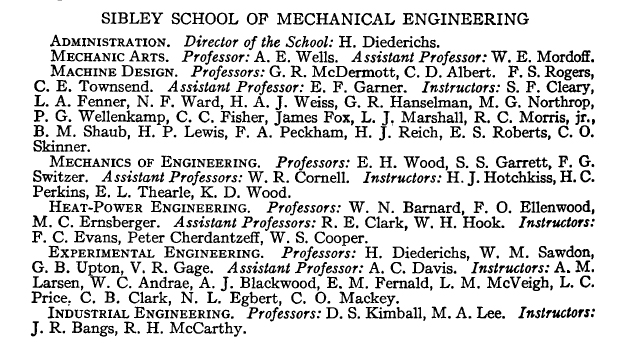
from the 1923-24 Cornell University Announcements.
Although the University failed to invest in the College of Engineering in the period 1910-1940, the Faculty helped maintain Cornell’s high reputation with the publication of many widely used textbooks in engineering education.
Aeronautical Engineering in the Sibley College and School
{From a lecture given to the student section of Cornell AIAA, Feb 2014}
Early history of aviation and Cornell
Octave Chanute was one of the early pioneers of aviation who began his investigations a decade before the Wright Brothers and conducted hundreds of glider tests outside Chicago. He and Thurston were members of the American Association for the Advancement of Science or AAAS. In 1886 at an AAAS meeting in Buffalo, Chanute had invited a speaker to talk about flying models and birds. The talk was controversial and in the audience were not only Thurston, but also Samuel Langley who became intrigued by the lack of hard science in the principles of flight.
In the late 1880's, Chanute communicated with almost all the principals in early aviation and wrote a series of articles tracing the history and progress in the Railroad and Engineering Journal, published by his friend Matthias Forney whom he knew from ACSE. In 1890 Thurston invited Chanute to lecture at Cornell Sibley College on progress in aviation. (See article in the Sibley J. of Engineering, 1890.) These lectures and articles were repackaged in Chanute's groundbreaking book, Progress in Flying Machines, in 1894. This book was read by the Wright brothers, c. 1899, before they built their first gliders.
In 1893, Octave Chanute along with Cornell graduate Albert Zahn, organized an International Conference on Aerial Navigation, at the Columbian Exposition in Chicago. Many of the principal players in aeronautics were present. Thurston attended along with Alexander Graham Bell. As evidence of the connectedness of this network we quote a letter from Robert Thurston of Cornell to his former student Albert Zahm, at Notre Dame, dated May 16, 1892 in response to Zahm's invitation to attend the Chicago Conference of Chanute.
"Your [letter] of the 14th is received. In reply I would say: The institution of an Aeronautical Congress would seem to me to be likely to prove an admirable move. I should think it certain to attract a great deal of attention and a large attendance. I would suggest the invitation of all members of the various aeronautical societies, of men like Langley, Maxim, Hargreaves [sic] and others who have actually done something to advance knowledge in that field, and to make the proposed invitation widely known through publications, like the Scientific American, which goes all over the world. I shall certainly attend, if possible and will endeavor to prepare a paper. Yours truly, R.N. Thurston"
Thurston is an example of an enhancing node in the early aviation network – one that is not a principal contributor [he presented a paper on "materials of aeronautic engineering" at Chanute's 1893 Chicago Conference] but one that linked important players together. Albert Zahm was Thurston's student who attended the Chanute lectures, and had graduated from Cornell in 1892. Zahm later convinced Chanute to organize an international conference on aerial navigation in 1893 at the Columbian Exposition in Chicago. Around 1900, Thurston was asked by his friend Langley to recommend a Cornell engineering graduate for the scale-up project of Langley's flying models and Charles Manly took the job. Manly was able to design and build one of the first radial internal combustion engines.
Thurston was a friend of Alexander Bell who was also a Cornell Sibley lecturer. Bell later organized the Aerial Experiment Association in 1907 out of which came Glenn Curtiss's 'June Bug' machine. William Durand was a younger colleague of Thurston at Cornell who would later go to Stanford, start propeller research and head up the new National Advisory Committee on Aeronautics in 1914. Another Sibley College student from Cornell was Elmer Sperry, who with his son developed a gyro controller for aircraft. Lionel Marks another Cornell grad taught at MIT and wrote an early textbook on aircraft engines.
Cornell's role in early aviation shows the increasing importance of research universities in technology innovation networks beginning at the middle of the 19th century. One of the first textbooks on airplane design was by Cornell Physics professor Frederick Bedell. Sibley students organized a Cornell Glider Club that built its own human carrying glider and competed with other Ivy League schools in flight competitions around 1910-1914.
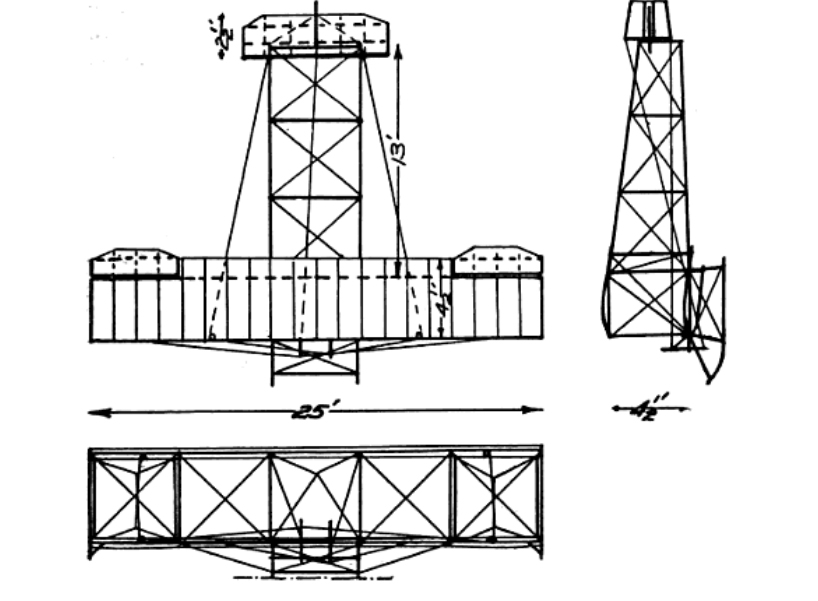
Cornell Sibley College produced outstanding graduates such as Sperry, Grumman, Manly, Zahm, Marks and Wood who became leaders in the early aviation industry. Marks wrote a textbook on aircraft engines, and KD Wood wrote an early textbook on airplane design. Carpenter wrote a popular textbook on internal combustion engines. A table of Cornell connected pioneers in aviation progress is shown below.
One of the key questions concerning the history of the Sibley College is why neither the faculty, nor the Director pushed to establish an aeronautical engineering program at Cornell considering the facts that:
i) the US Army had set up an aviation ground school at Cornell in 1917
ii) the Morse company was manufacturing airplanes in Ithaca circa 1917
iii) one of the world’s principal aircraft enterprises was in Hammondsport NY
iv) there was student interest enough to build flyable gliders
As mentioned earlier, the School did establish an Aeronautics Option in the 1930’s but waited until the end of WWII to create a robust program and then in a separate School GSAE.
In reading the history of this era, a number of authors, including Morris Bishop and former Dean Kimball, agreed that the Trustees had let engineering live on its laurels after the deaths of Dean Fuertes in Civil and Thurston in Sibley in 1903. After 1910, enrollments in engineering began to decline and there was little investment in new equipment and buildings. It was not until the Deanship of Solomon Hollister that Cornell engineering would attempt to reclaim the esteem it had at the end of its first half-century.

Sibley College Museum and Collections
In Robert Thurston's travels to Europe in 1873 as the US Ambassador to the Vienna Exhibition of Machines and Manufacturing, he noted the widespread use of teaching models and collections at European technical schools including those in Berlin, Dresden and Paris. Cornell's first president Andrew Dickson White had made a similar observation during his tour of duty as the US Ambassador to Germany from 1880-82. Both educators had visited Professor Franz Reuleaux of Berlin and noted the fine collections of kinematic models illustrating the components of machine design and construction. White convinced Hiram Sibley to provide $8000 [multiply by 100 in today's dollars] for the purchase of 250 models designed by Reuleaux and manufactured by Gustav Voigt of Berlin. They were delivered to Cornell beginning in 1882.
By the time Thurston arrived at Cornell from Steven's Tech in 1885, there was a Sibley Museum in Sibley Hall on the north end of campus. The museum was featured on the cover of an 1885 issue of Scientific American. These collections were also mentioned in a 1891 book on Cornell by Frank C. Perkins, Cornell University and her General and Technical Courses as well in in Cornell University Catalogs.
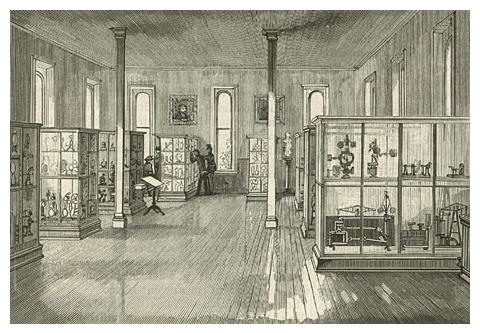
Reuleaux Collection of kinematic mechanisms.
In the late 1950’s, the School of Mechanical Engineering was moved from the north campus in Sibley Hall to its current location in Upson Hall at the south end of campus adjacent to Cascadilla Gorge. The ‘museum’ was reconstituted in a series of wooden display cabinets on the 3rd floor of Upson Hall as part of the machine design section of the Sibley School. However many other models such as steam engines and gas engines, were relegated to storage rooms. Some models were ‘given away’ in the rush to clean out the old Sibley building while others simply disappeared.
Sometime in the 1970’s however, this space was occupied by the Department of Computer Science. Although mechanical engineering students no longer saw these models on a daily basis, former CS Chair, John Hopcroft and later Dean of the College, remembers being inspired by the kinematic models and wrote several papers on the theory of computing based on a few of the mechanisms of Reuleaux. Hopcroft became a winner of the prodigious Turing Prize in Computer Science and Dean of Engineering.
During the 1960’s and 1970’s, the late Professor Richard Phelan and his student Professor Jack Booker acted as curators for the collection using the models in the teaching of machine design and providing an inventory of the artifacts.
During the term of Director Sidney Leibovich in the late 1990’s, Computer Science wanted to move the Reuleaux displays off the 3rd floor in Upson to provide hallway seating for students to access computing services. With less than a week to provide a plan, Leibovich and curator FC Moon decided to move the collection in its wooden and glass cabinets to the 2nd floor hallways of Upson Hall.
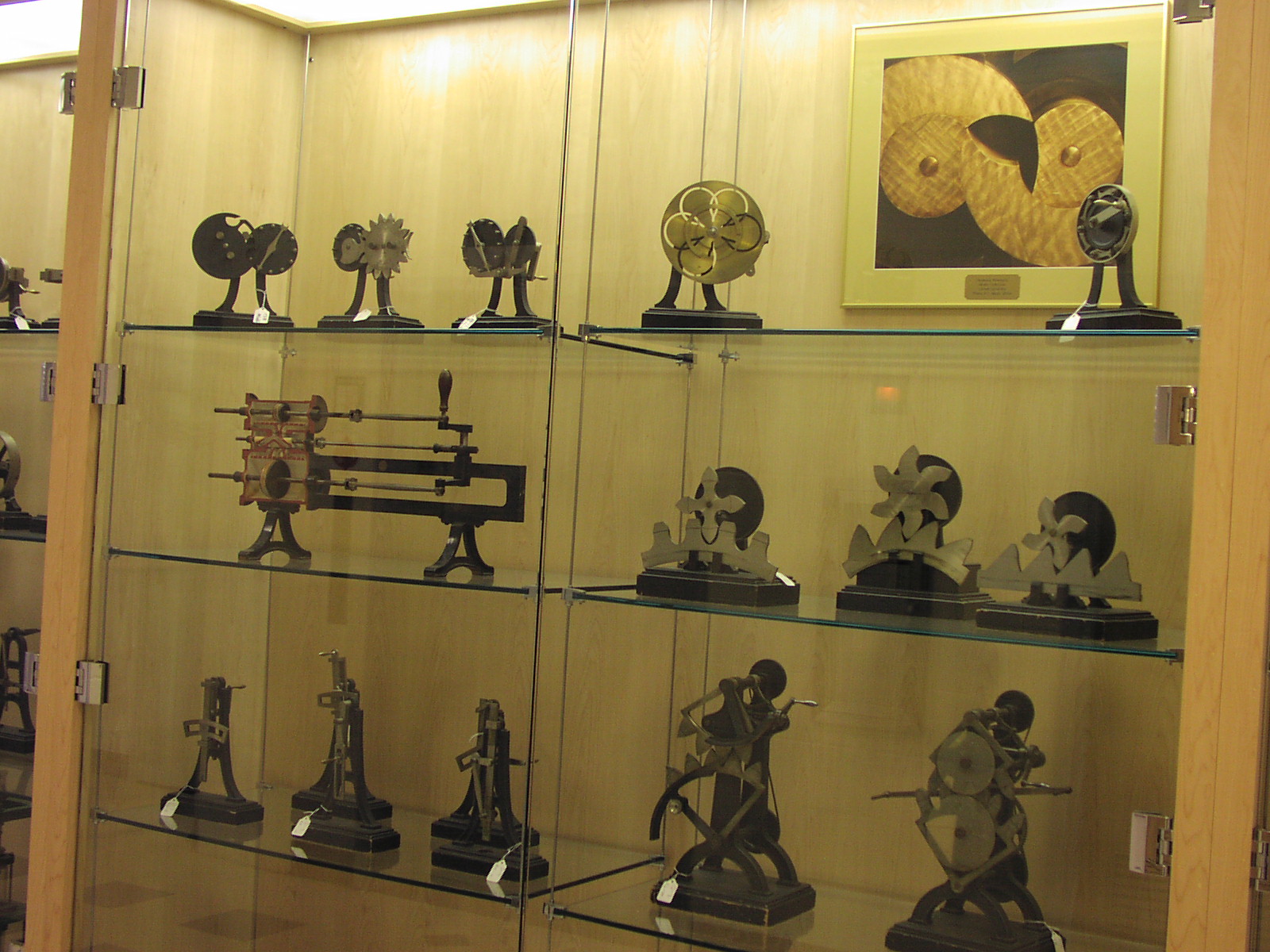
Beginning in 1995 with visits to Germany by curator and former director FC Moon, it became clear that Cornell had in its possession a valuable collection of historical significance to the history of mechanical engineering and machine design. In 1997, Moon published a review of the life of Franz Reuleaux and his contributions to kinematics of machines in the respected journal Applied Mechanics Reviews.
In 2002, Moon and John Saylor, head of the Engineering Library, made a proposal to the National Science Foundation to create a website for the Reuleaux collection. This proposal included participation of Professor Hod Lipson and mathematicians David Henderson and Daina Taimina. Lipson proposed to create 3D printed models of many of the brass and iron models. This project was awarded $750K and was later awarded another $500K. The website title suggested by Saylor was “Kinematic Models for Design Digital Laboratory” or KMODDL.
With the construction of the new atrium attached to Duffield Hall, funds were provided by the College for modern display cabinets and the collection was moved again in 2004.
In 2004, curator Francis Moon made a proposal to the History and Heritage Committee of the ASME, and the Cornell Collection of Reuleaux Models and associated artifacts were designated a National Historic Collection in a ceremony in the atrium of the new Duffield Hall attended by the Provost Biddy Martin. Dean Kent Fuchs gave funds for a flat panel screen display for the KMODDL website in the Atrium. Displays were also constructed in the first floor hallway of Upson Hall. During this time other models were found including small models of steam engines and a gas engine as well as many artifacts for computing such as slide rules, planimeters for integrating areas, and a 1895 mechanical calculator called the ‘Millionaire’. Also displayed was one of the rare full scale cutaways of a 1950’s era internal combustion engine.
In the decade since the 2004 ASME designation, the KMODDL website has seen continued use around the world. User visits to KMODDL were logged at over 300,000 per year. Also other universities such as the Technical University at Aachen, Moscow Technical University, University of Porto in Portugal and the National Taiwan University at Tainan, have constructed similar websites of their kinematic model collections inspired by KMODDL.
After WWII, a few German universities rebuilt their lost engineering teaching model collections such as at Berlin, Aachen and Dresden. However almost all are displayed in restricted laboratory conditions. Karlsruhe Institute of Technology has recently publicly displayed its 100+ Redtenbacher kinematic models that were to inspire one of its graduates Franz Reuleaux to build his own collection. About half of the Deutsches Museum collection of about 60 Reuleaux model are in storage. At this time [c. 2015] the Cornell Sibley School has the largest public display of kinematic models in the world and in its present location in the Atrium and Upson Hall is viewed by hundreds of viewers each day. The Reuleaux Models as displayed provide what NSF calls ‘informal’ technical learning opportunities. Recently, the teaching of kinematics has seen resurgence with interest in robotics.
Educational Uses of Sibley Collection
In the past decade, the Cornell kinematic models have been used in the teaching of MAE 2250 as part of the sophomore design synthesis course. Professor Moon has given in-class lecture demonstrations of the variety and principles of kinematic mechanisms. Students have also provided CAD files on the models for the KMODDL website as well as using various mechanisms to design different air motor prototypes. Lecture demonstrations were also given to the ASME student section for several years.
In 2004 and recently in 2014, the School of Architecture has borrowed Reuleaux models to use in their freshman drawing class. Again Professor Moon provided an introductory lecture on kinematics and mechanisms.
Since 2004, the models have been used as demonstrations for ‘Bring a child to work day” as well as middle school class visits to Cornell.
From 2000 to 2011, Professor Moon used the models in his senior course, Introduction to Robotics (MAE 417/517), to illustrate the mechanism components of robotic manipulator design including medical surgical robotics.
In 2011 when Moon retired, Professor Hod Lipson became the Collection Curator. He has since added ‘QR’ dot codes to all the Reuleaux models on display in Upson and Duffield Atrium models. These codes can be read with cell phone apps such as ‘SCAMLIFE’ that will bring up the KMODDL page with the model descriptions as well as model motion videos.
In 2015-2016, the Sibley Model Collections are scheduled to be moved again into the newly renovated Upson Hall.
When the Department of Engineering Mechanics and Materials was created circa 1950, some of the historic artifacts of the Sibley School related to solid mechanics were moved into Thurston Hall.
Morse-Vail Telegraph Receiving and Recording Apparatus of 1842
In 1842 the Morse-Vail-Cornell magnetic telegraph system was successfully tested between Baltimore and Washington DC. This system became the source of wealth for Ezra Cornell and the eventual establishment of Cornell University, as well as for Hiram Sibley. In 1890, Sibley’s son purchased one of the two receivers and donated it to the Sibley College Museum. After the move the present campus, the telegraph was stored in a closet in the Dean’s Office. It has recently been moved to the Rare Books Library in Olin Hall and in 2015 is on view there. The other receiver is in the Smithsonian Institution in Washington.
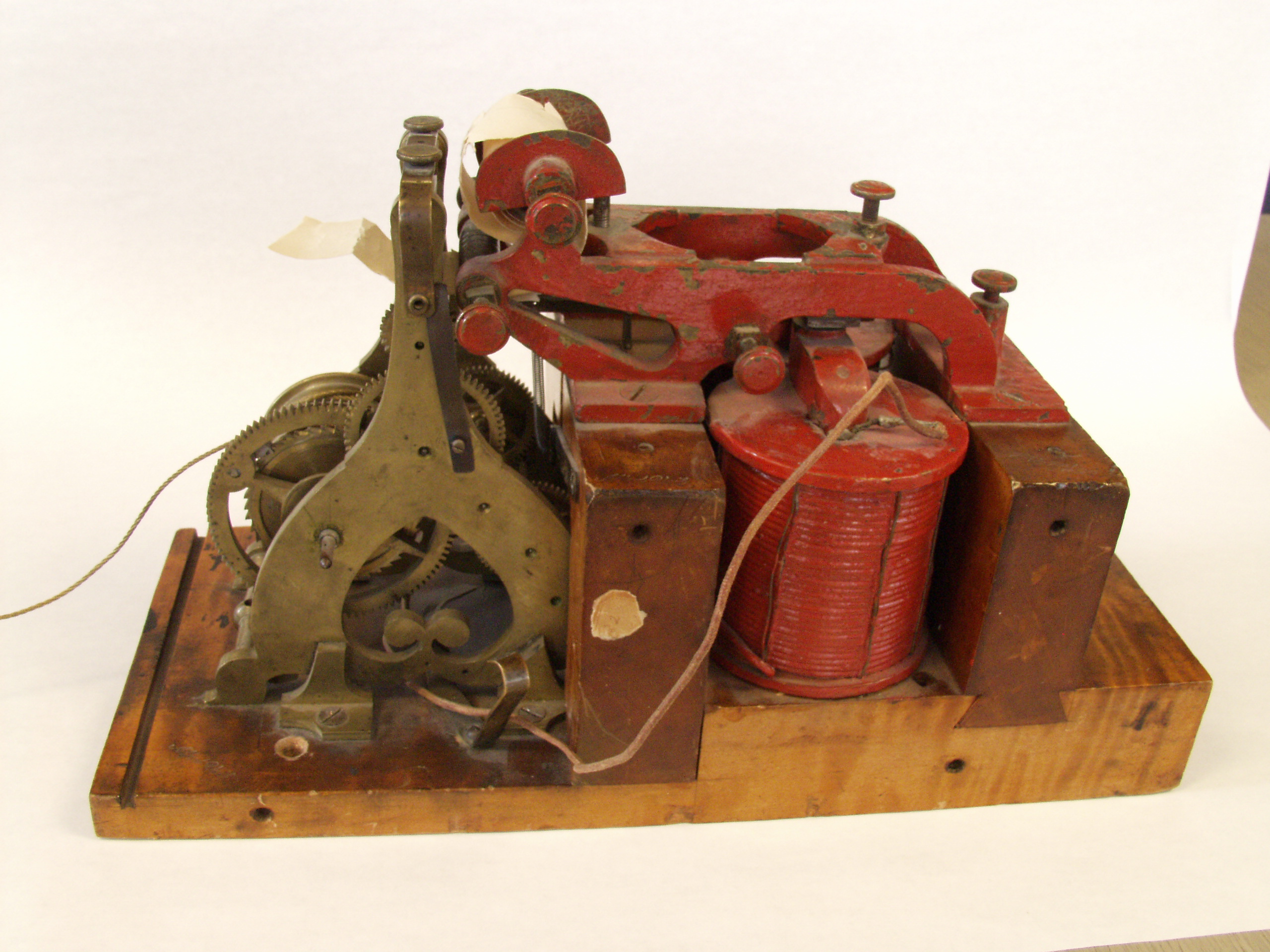
Formerly on view in the Sibley Museum, it is now in the Cornell Library Rare Books Collection.
In 2006, a 3D printed working model was constructed in the laboratory of Professor Hod Lipson. It is currently on view in the Cornell Rare Books Collection in Olin Library.
Robert Thurston Testing of Materials Artifacts In addition to his worldwide reputation as an expert on the steam engine, Thurston was a pioneer in the testing of properties of materials. He designed and built several unique machines for testing strength of metals and wood and a machine to measure the viscosity of lubricants. Two of these testing machines are in the current collection of the School; Thurston’s patented “Autographic Testing Machine” shown below, and a device for measuring the viscosity of oil. [Housed in a display cabinet in Thurston Hall, first floor]
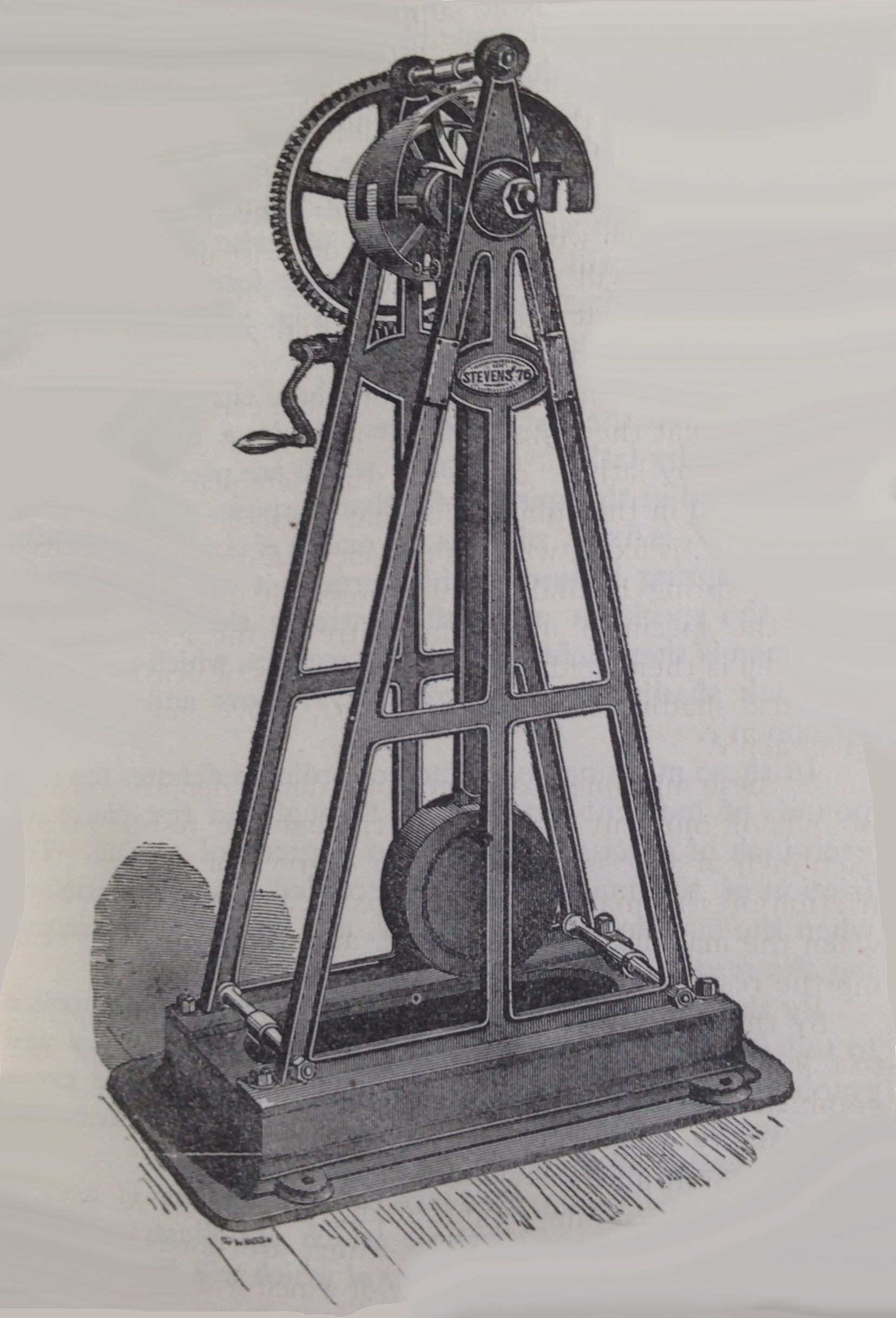
Thurston used this patented device to discover work hardening in metals in the late 19th century.
Shown below is one of the original testing machines for measuring the bending of elastic beams. It has been used for over a century in the sophomore course on the mechanics of solids. It is currently located in the teaching laboratory of Thurston Hall.
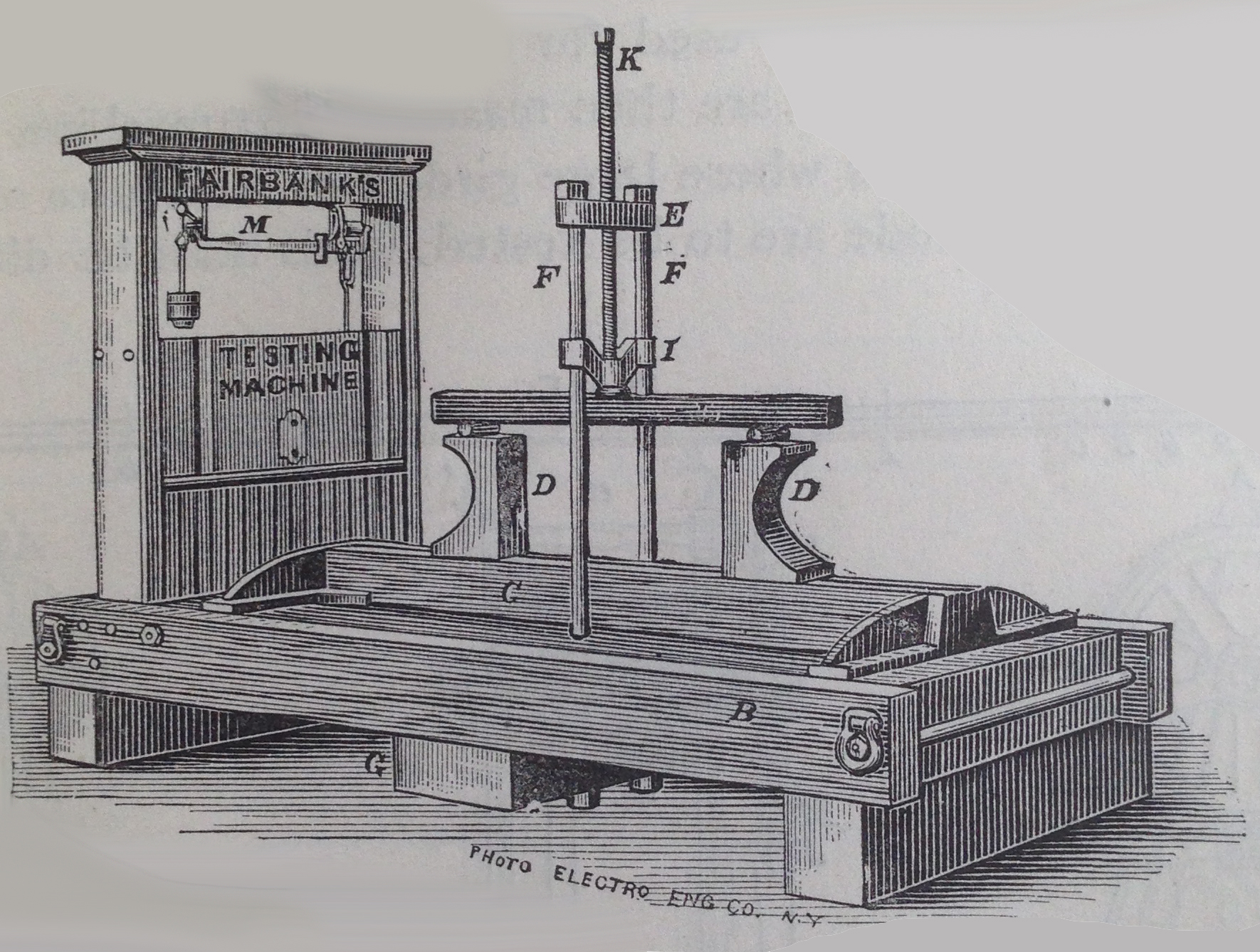
Art Collection of the Sibley School
The School has several oil portraits of prominent alumni and donors. However it also has unique pieces of museum quality art tucked away in various places:
i) Bas-relief bronze sculpture of Robert Thurston by renowned sculptor Hermon A. McNeil located in the first floor of Thurston Hall. A copy is at the ASME Headquarters in New York.
ii) Seven Lithographs of the pioneers of flight donated by Theodore Wright who was vice President of Research at Cornell and Acting President. These lithographs hung in the Graduate School of Aeronautical Engineering in Grumman Hall in the 1960’s and were then found in the MAE copy machine room in Upson in the 1990’s. They are stored in a safe place in the School today.
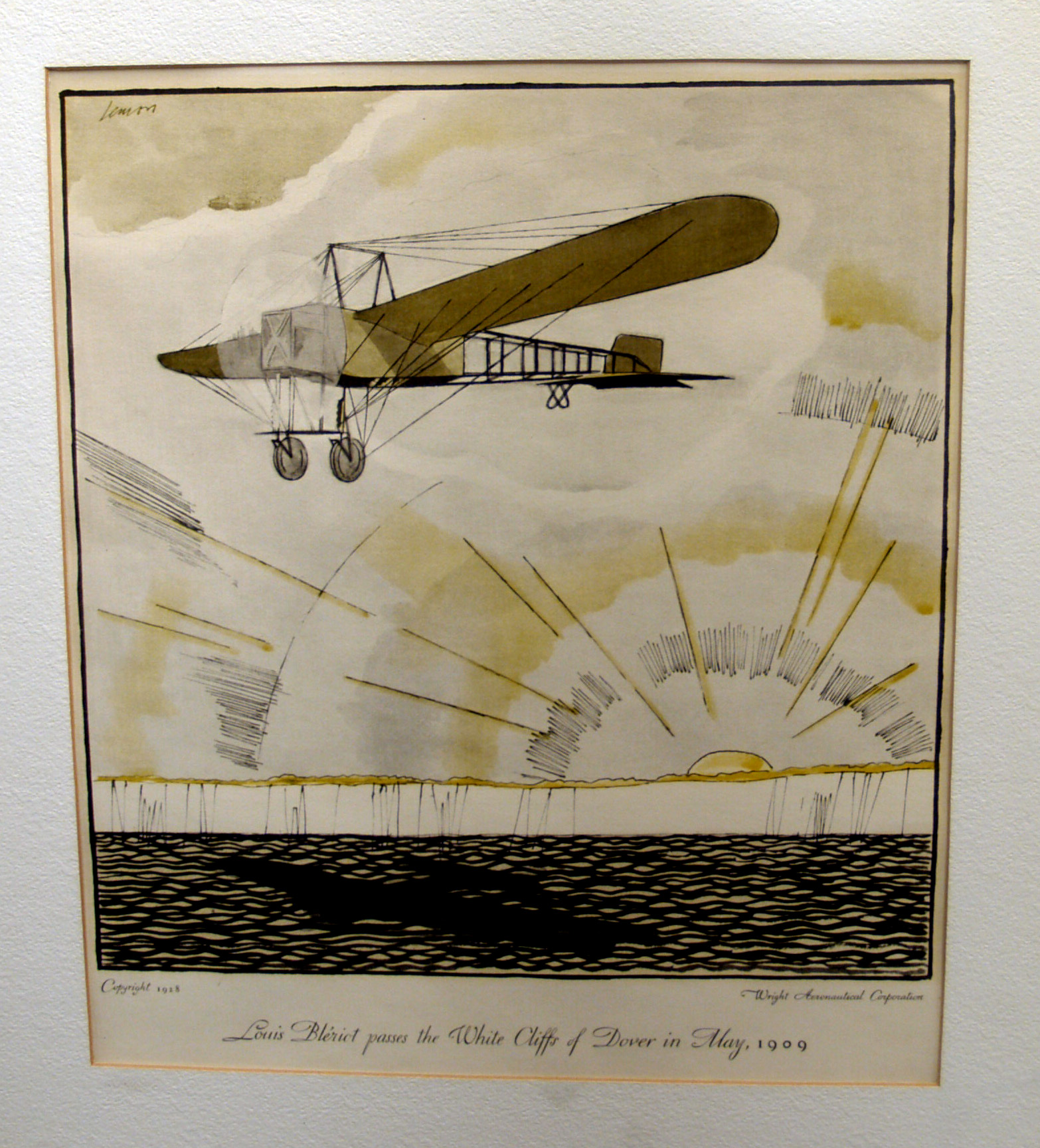
The lithograph shows the flight of Louis Bleriot crossing the English Channel in 1907.
iii) Oil reproduction of James Watt Portrait from the London Portrait Gallery, commissioned by the Institution of Mechanical Engineers in the 1930’s as a gift to the US Western Society of Engineers. The portrait was then given to Cornell but ended up in the janitor’s closet in Upson Hall. It is now hung in a secure place by not in public view. In the painting Watt is shown admiring a straight-line mechanism used in his steam engine invention. Appropriately the Reuleaux Collection had a model of Watt’s mechanism.
iv) Research-inspired art by artist Teresa Howley. Howley worked for MAE in the late 1980’s and 1990’s as a drafter and artist, making figures for faculty research papers. Inspired by some of the computational work of Prof David Caughey in fluid mechanics and F. Moon’s research on magneto-mechanics, she created paintings that are hung in the entrance to Rhodes Hall and in the MAE faculty conference room in Rhodes Hall. Howley is also a talented sculptor.
Sibley College Art Department
In the late 19th century, the Sibley College created an art department to teach students of engineering and architecture students drafting, freehand drawing and industrial art. The department used some of the classical casts of European sculpture collected by Andrew D White. With Thurston’s encouragement, one of the instructors, Hermon A. McNeil, left Cornell and studied sculpture in Europe. Later McNeil was commissioned to sculpt the statute of Ezra Cornell in the Arts Quad. He also was commissioned by ASME to do the bas-relief of Thurston, now in Thurston Hall.
The art and drawing department were later transferred to the Department of Architecture and White Hall.
References and Sources
Altschuler, G.C. and I. Kramnick (2014) Cornell; A History, 1940-2015, Cornell University Press, Ithaca, NY.
ASME (1915) A History of the American Society of Mechanical Engineers from 1880-1915, ASME NY
Bishop, M (1962) A History of Cornell, Cornell University Press
Calvert, M.A. (1967) The Mechanical Engineer in America, 1930-1910: Professional Cultures in Conflict, Part II, Chapter 5, “School versus Shop: Cornell’s Sibley College”, pp 87-106
Cornell Alumni News
Cornell Daily Sun
Cornell Announcements (Course Catalog 1913-14)
Cranch, E.T. (1957) “Plan for the Department of Engineering Mechanics and Materials”
Diederichs, H. (1935) “The Curriculum in Mechanical Engineering” The Sibley J. of Engineering Cornell University, Vol XLIX, Number Four, April 1935. pp 71-73, 77
Durand, W.F. (1944) Selected Papers of William Frederick Durand, California Institute of Technology
Durand, W.F. Robert H. Thurston, a Biography
Engineering Quarterly (1979) Vol 14, No.2 “A Long Look at Mechanical Engineering”
Engineering Quarterly (1971) Vol 6, No.3 “Capstones of Century I” Edited by D. Berth and G.J. McConkey
Hewett, W. T. (1905) Cornell University: A History, Vol II, Chap IV, “Sibley College of Mechanical Engineering”, pp 303-325
Howes, R. F. (1971) A Cornell Notebook, Cornell Alumni Association, Ithaca, NY
Kimball, D.S. (1935) “The Story of Sibley College of Mechanical Engineering and The Mechanic Arts” The Sibley J. of Engineering Cornell University, Vol XLIX, Number Four, April 1935, pp 65-67, 80-82
Kimball, D. S. (1953) I Remember, McGraw-Hill Book Co, NY.
Moon, F.C. (2004) “The Reuleaux Collection of Kinematic Mechanisms at Cornell University: An ASME Mechanical Engineering Heritage Collection” Dedication Brochure ASME, NY.
Moore, F. (2004) “A History of Education in Aerospace Engineering at Cornell University”, pp 216-225, in Aerospace Engineering Education during the First Century of Flight, AIAA
Perkins F.C. (1891) Cornell University; Her General and Technical Courses, Art Printing Works, Buffalo NY
Sears, W.R. (1994) Stories From a 20th Century Life, Parabolic Press, Stanford CA
Segelken, H.R. (2009) Cornell Engineering, A Tradition of Leadership and Innovation, Cornell University Office of Publications and Marketing
Sibley Journal of Engineering (1885-1935)
Thurston, R.N. (1897-98) “Work of the Founders; The early History of Sibley College” Sibley J. of Engineering, Vol !2, No. 6, March 1898, pp 255-260
Thurston, R.N. (1875) Vienna International Exhibition 1873, Report on Machinery and Manufactures with an Account of European Manufacturing Districts, Government Printing Office, , Washington DC
Thurston, R.H. (1873) “Torsional Resistance of Materials Determined by a New Apparatus, with Automatic Registry”, J. of The Franklin Institute, reprinted in Thurston’s bound Memoirs and Professional Reports
Thurston, R.N. (1890) Heat as a Form of Energy, Houghton Mifflin and Co, Boston
Von Engeln, O. D. ’08 (1909) At Cornell, The Art Press, Syracuse NY
Von Engeln, O. D. ’08 (1917) Concerning Cornell, Chapter III, p 204. Geography Supply Bureau Publishers, Ithaca, NY
Young, C.V. P. (1954) Cornell in Pictures, Cornell University Press, Ithaca, NY
White, A.D. (1905) Autobiography of Andrew Dickson White, Part I, The Century Co. NY.
Wikipedia (misc Sibley Biographies)
Appendix I - Deans and Directors of the Sibley College & School
Eli Whitney Blake Jr. [1868-1869?] {College of Mechanic Arts}
John Lewis Morris [1870-1885] {1871-Sibley College of Mechanic Arts} Appointed by President Andrew D. White
**John Edson Sweet (1832-1916) [Cornell 1873-79? Dir. of College Shops] **Did not have administrative title of Dean
Robert H Thurston [1885-03] {Sibley College of Mechanical Engineering & Mechanic Arts}, Appointed by President Andrew D. White
Albert W. Smith ’78 [1904-1921] {Sibley College of Mechanical Engineering}
1919: Merger of the College of Civil Engineering and the Sibley College into the College of Engineering: With three Schools
- School of Civil Engineering
- School of Electrical Engineering Sibley
- School of Mechanical Engineering
Herman Diederichs [1921-1935] {Sibley School of Mechanical Engineering}
William N Barnard ’97? [1935-37] Acting, [1937-1948?], Appointed by Dean C. Hollister
William Julian King [1948?-1950], Appointed by Dean C. Hollister
Harry John Loberg [1950-1965?]
George R. Hanselman, Int.Dir. [1965]
Dennis G. Shepard [1965-1972]
Edwin L. Resler Jr. [1972-1977] {Sibley School of Mechanical and Aerospace Engineering}
Albert R. George [1977-1987] Appointed by Dean Andrew Schultz or Corson?
Francis C. Moon ‘G 67’ [1987-1992], Appointed by Dean William Streett
Franklin Moore ‘G42’ [1992-1993], Appointed by Dean William Streett
David A Caughey [1993-1998]
Sidney Leibovich ‘G 66’ [1998- 2005] Appointed by Dean John Hopcroft
Lance Collins [2005- 2010] {Sibley School of Mechanical and Aerospace Engineering +Theoretical and Applied Mechanics}
Alan Zehnder [2010- 2011] Acting Director
Mark Campbell [2011-] Appointed by Dean Lance Collins
Appendix II - Chairs of the Department of Theoretical and Applied Mechanics
Note: In the Cornell College of Engineering and its predecessors, before 1919, the College of Civil Engineering and the Sibley College of Mechanical Engineering had departments of mechanics or engineering mechanics. In the late 1950's, College of Engineering Dean Hollister created two graduate mechanics departments. The first was the Graduate School of Aeronautical Engineering under Professor William R. Sears, and the second was the Department of Engineering Mechanics and Materials. This department was created from faculty from both Civil and Mechanical Engineering. A few years later materials separated into Materials Science and Engineering and in 1959 mechanics took the name Theoretical and Applied Mechanics.
Early Heads of Mechanics Departments
1910 - ? Edgar Harper Wood, Head of the Department of Mechanics, Sibley College
1940-1947 James Goodier, Head of Department of Mechanics, Sibley School
Chairs of T&AM
1947-1956 Dwight F. Gunder [Chair of Department of Engineering Mechanics and Materials]
1959-1962; 1966-1968 Edmund T Cranch
1962-1966 John R. Moynihan
1968-1972 Bruno Boley
1973-1974 Richard H. Lance
1975-1980 Yih Hsing Pao
1980-1987 Francis C. Moon
1987-1992 Joseph A. Burns
1992-2000 James T. Jenkins
2000-2008 Timothy J. Healey
2008-2009 Alan T. Zehnder
Appendix III - Sibley School, Aero School and T&AM Members of National Academy of Engineering and NAS: Former Students and Current and Former Faculty
Note: The National Academy of Engineering was founded in 1964 and is relatively young compared to the National Academy of Science [founded in 1863]. NAS had a small section for engineers until the founding of NAE. NAS, NAE and the Institute of Medicine form the National Academies as a single unit advising the Government and overseeing the National Research Council.
1917 [NAS] William F Durand, Faculty c.1890-1905
1967 Alexander H. Flax, Cornell Aero Lab, Faculty GSAE c. 1950s
1968 William R. Sears, Director GSAE 1946-1963
1974 George F. Carrier, PhD [Goodier, c. 1946]
1975 Bruno Boley, Faculty, Chair T&AM 1968-72
1977 Arthur Kantrowitz, Faculty GSAE
1983 John G. Bollinger, MS ME 1958
198x Donald L. Turcotte [NAS] M.Aero E 1955, Faculty GSAE
1984 Franklin K. Moore, PhD GSAE [Sears] Faculty
1984 Paul Nagdhi, BS ME 1946
1984 James W. Dally, Assist Prof T&AM c. 1960
1985 Yih-Hsing Pao Faculty T&AM 1960-
1985 Shen-Fu Shen, Faculty GSAE c. 1960
1985 Richard J. Goldstein, BS ME 1948
1985 A. Richard Seebass, Faculty GSAE
1987 Herbert H. Johnson Faculty T&AM c.1960
1989 Kuo K. Wang, Faculty MAE
1991 John Lumley, Faculty MAE
1993 Sidney Liebovich, PhD T&AM [Ludford], Faculty MAE 1967-, Director MAE
1993 Nicholas Rott, Faculty GSAE
1996 Francis C. Moon, PhD T&AM [Pao], Chair T&AM 1980-87, Dir. MAE 1987-92
1998 James A. Fay, PhD, Enr'g Mechanics 1951; Assist Prof 1951-1955
1998 Arthur M. Geoffrion, BME 1960
1998 William Maxwell BME 1957
1999 Kyle T. Alfriend, Faculty T&AM c. 1974
2002 David M. Lederman, BS, MENG, ME 1967
2004 David C. Wisler, MS Aero E 1965
2006 A. Galip Ulsoy, MS ME 1975
2009 John A. Swanson, M ME 197x
2010 Stephen Pope, Faculty MAE
2011 Nadine Aubrey, PhD c. 1994[Lumley]
Appendix IV - Oral History Project of Faculty in the Sibley School of Mechanical and Aerospace Engineering
Note: In 2013-14 the Cornell Association of Professors Emeritus [CAPE] conducted video recorded interviews of seventeen MAE/T&AM senior and retired faculty through the work of Prof Emeriti Robert Cooke, Francis Moon, Sid Leibovich, and John Abel. These interviews have been archived on the Cornell University web page: eCommons.cornell.edu.
The files may be searched for under several titles;
"Legacy of Faculty and Staff"
"Collections; An Oral History Project of the Sibley School of Mechanical and Aerospace Engineering"
Search under individual faculty name. View under 'Streaming Video'
The list of the faculty members who have been interviewed are as followed;
Bartel, Donald L.
Booker, John, F.
Burns, Joseph
Caughey, David A.
Cranch, Edmund T.
de Boer, P.C.Tobias
George, Albert R.
Gouldin, Frederick C. [Not uploaded on ecommons as of Jan 2015]
Leibovich, Sidney
Lumley, John
Moon, Francis C.
Moore, Franklin K.
Collins, Lance
Voelcker, Herb
Warhaft, Zellman [Not uploaded on ecommons as of Jan 2015]
Wang, Kuo-King
Zehnder, Alan T. [Not uploaded on ecommons as of Jan 2015]
Appendix V - Sibley College and School Bios Sampler Mechanical Engineering, Aeronautical Engineering, Theoretical and Applied Mechanics at Cornell University 1865-2015
Robert H. Thurston [1839-1903]
Second Dean/Director of Sibley College 1885-1903
Robert Thurston was the Director of the Sibley College of Mechanical Engineering and Mechanic Arts at Cornell from 1885-1903. He led the College during a period of exponential growth in student enrollment at the end of which Sibley College was one of the major producers of university trained mechanical and electrical engineers at the turn of the century. He chose the title of Director as he wanted the power of hiring faculty and staff that was at that time denied the position of dean. Before coming to Cornell, Thurston taught at the US Naval Academy and was one of the founding professors of Stevens Institute in New Jersey across the bay from New York City. Thurston had created an educational model based on mathematics, science and practical training that was emulated by the great Professor Franz Reuleaux at Berlin. He also believed in the testing of materials for engineering design and created an educational testing laboratory for undergraduates.
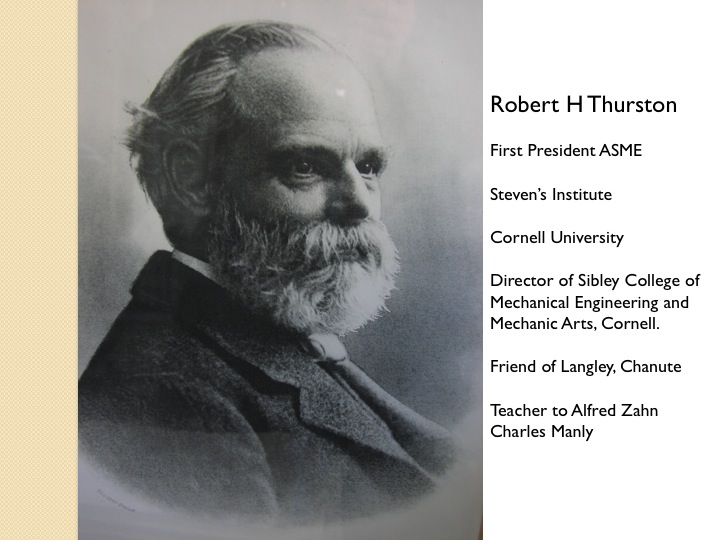
Under Thurston’s reorganization of the Sibley College, the enrollment grew in candidates for the M.E. degree from 63 in 1885 to 958 in 1904 the year after his death. The instructional staff in the College in 1904 was 45 organized in seven departments. The number of Mechanical Engineer degrees awarded in 1903 was 157. The departments in 1904 were; Mechanic Arts, Machine Design, Experimental Engineering, Steam Engineering, Electrical Engineering, Naval Architecture and Marine Engineering, and Railroad Engineering.
Thurston was elected the first president of the newly created American Society of Mechanical Engineers or ASME in 1880. He was friends with many prominent scientists, inventors and engineers including Langley, Head of the Smithsonian Institution, Alexander Graham Bell and Octave Chanute, president of ASCE and confidant and advisor to the Wright Brothers.
Thurston was internationally known, having been the US envoy to the Vienna World’s Exposition in 1873. He was a world expert on the steam engine and thermodynamics and had translated Carnot’s famous work on the subject from French into English. Thurston was also a well-known author of a treatise on materials of engineering. He invented and patented a torsional testing machine with which he discovered work hardening of metals. Today, this machine is in the sophomore materials testing lab at Cornell. During his tenure at Cornell he hired many famous professors including William Durand who later went to Stanford University and became the head of the National Advisory Commission on Aeronautics [NACA] in 1914 the precursor of NASA. Charles Manly, one of his students, designed and built the radial engine for Langley’s airplane in 1903.
During his tenure at Cornell, he started the Sibley Journal of Engineering. He also hired Hermon Atkins McNeil as an art instructor in the engineering drawing classes in the College. Thurston encouraged McNeil to obtain further training in Europe. He returned from Paris an accomplished sculptor and was later commissioned to create the statute of Ezra Cornell on the Arts Quadrangle at Cornell. When Thurston died, ASME asked Hermon McNeil to design a bronze bas-relief sculpture for ASME headquarters in NYC, and a copy is hanging in the entry hall of Thurston Hall. On the occasion of the hundredth anniversary of Thurston’s birth, a celebratory conference was held at Cornell. A biography of Robert Thurston was written by William Durand. Ithaca’s Thurston Avenue was named after him and the center building of the Engineering Quad was named for Thurston in the late 1950’s originally housing the Department of Engineering Mechanics and Materials.
References
AD White “Autobiography”
ASME History Website
Hewett, “A History of Cornell” 1904
Calvert, “History of Mechanical Engineering”
W. Durand, “Robert H. Thurston, a Biography”
Hiram Sibley [1807-1888]
Cornell Trustee, Benefactor
Hiram Sibley was born in Massachusetts and eventually settled in Rochester New York. He met Ezra Cornell and Thomas Morse and assisted them in getting aid from Congress to put up the first successful telegraph line in 1842 from Baltimore to Washington DC. He later worked to consolidate many individual telegraph companies into the Western Union Telegraph Company of Chicago. The assets rose to $40,000,000 and he retired in 1869. Cornell was one of the shareholders in the company. Cornell put some of his wealth into the forming of the University and Sibley placed some of his wealth into the College of Mechanic Arts and Mechanical Engineering. He was a founding member of the Board of Trustees and attended every meeting until his death. His son Hiram W. Sibley continued his father’s philanthropy to the University and the College until the beginning of the 20th century.
When the first class of students arrived in 1868, the fledgling university was under obligation to offer instruction in the ‘mechanic arts’. Andrew D. White in his memoirs writes that aside from hiring John Morris as a professor of mechanic arts, no one had a good idea what the curriculum should entail. There was no equipment to illustrate let alone teach students the skills and principles of the field. White says he used his own money to purchase one lathe for instruction. Confiding in Hiram Sibley about the problem, Sibley offered to build a separate building on the northwest corner of the new campus as a new College of Mechanic Arts and to equip the college with machines and collections.
In 1870, the college was thus named The Sibley College of Mechanic arts and John Morris was its Dean and John Sweet was hired in 1873 as head of shops. West Sibley was 100 feet by 40 feet and three stories high. For a time the department of botany occupied the new building as well. East Sibley, the Dome, shop buildings and a foundry were later added.
The accounts of Mr. Sibley show a total of $150,000 initially given for Sibley College including; $8000 for purchasing the Reuleaux Collection of Kinematic Models in 1882, an endowment fund of $50,000, and money for scholarships. Later the total funds that Hiram and his son contributed would amount to over $300,000 to the Sibley College.
{According to measuringworth.com, $100 in 1875 is worth in CPI terms about $2200. However the worth in terms of “economic value” had it been invested is $29,000.}
Reference
Hewett, W.T. [1904] Cornell University, A History, Volume Two, Chapter IV, pp 303-306
Maxwell Upson [1876-19zz]
Sibley Student, M.E. 1899, Cornell Trustee, Benefactor
Maxwell M. Upson was born in Wisconsin in 1876 and lived on a farm in North Dakota. He received an A.B. degree from the University of North Dakota in 1896 and enrolled in Cornell Sibley College in 1896 graduating with an M.E. degree in 1899. His early technical work involved building boiler plants in the US and Canada. He eventually became vice president and later Chair of the board of a concrete pile company Raymond International.
He was an enthusiastic Cornellian, serving as business manager of the Sibley Journal of Engineering and later associated with the Cornell Engineering Society and the Cornell Club of New York.
Maxwell Upson was awarded the Edward Longstreth Medal of The Franklin Institute of Philadelphia in 1940 for his contributions as an Inventor in the Industrial Arts.
Upson was elected to the Cornell Board of Trustees in 1925 and server for 35 years. He and his wife donated close to two million dollars for the construction of a new mechanical engineering building on the south campus in 1956 and contributed several millions toward faculty chair endowments that benefited faculty in engineering and the Arts colleges.
Eventually Computer Science and Operations Research occupied part of the building. Also the Plasma Studies Group occupied part of the basement laboratory. ORIE moved out when Rhodes Hall was built in the 1990’s and CS moved out in 2014. The original building was designed by architects Perkins and Will of Chicago and was completed in 1958. Oddly the current architects for the recent renovation in Upson Hall in 2014 are also from Perkins and Will.
References
Morris Bishop (1967) A History of Cornell
Cornell Daily Sun Archives
Wikipedia
Rolla Clinton Carpenter [1852-1919]
Sibley College Faculty [1890-1917]
Professor Rolla Carpenter was one of the pioneers of climate-controlled buildings and wrote one of the first books on heating and ventilating. He was one of the professors of Willis Carrier (Class of 1900) who is often credited with the invention of air conditioning. Carpenter was born in Lake Orion, Michigan and attended Michigan State [BS 1873] and the University of Michigan. He worked as a civil engineer before accepting a teaching position at MSU as a professor of mathematics and civil engineering. His father owned a large farm in Michigan and was a vice president of a Michigan railroad company.
During his summers he took courses at MIT and Cornell earning a Master of Mechanical Engineering degree from Cornell in 1888 before accepting an associate professor position in the Sibley College in 1890 as head of the experimental laboratories. He played an important role in designing the campus facilities which include the heating facilities for buildings and the Mechanical Shops at Michigan Agricultural College or MAC (now MSU) [1875-1890].
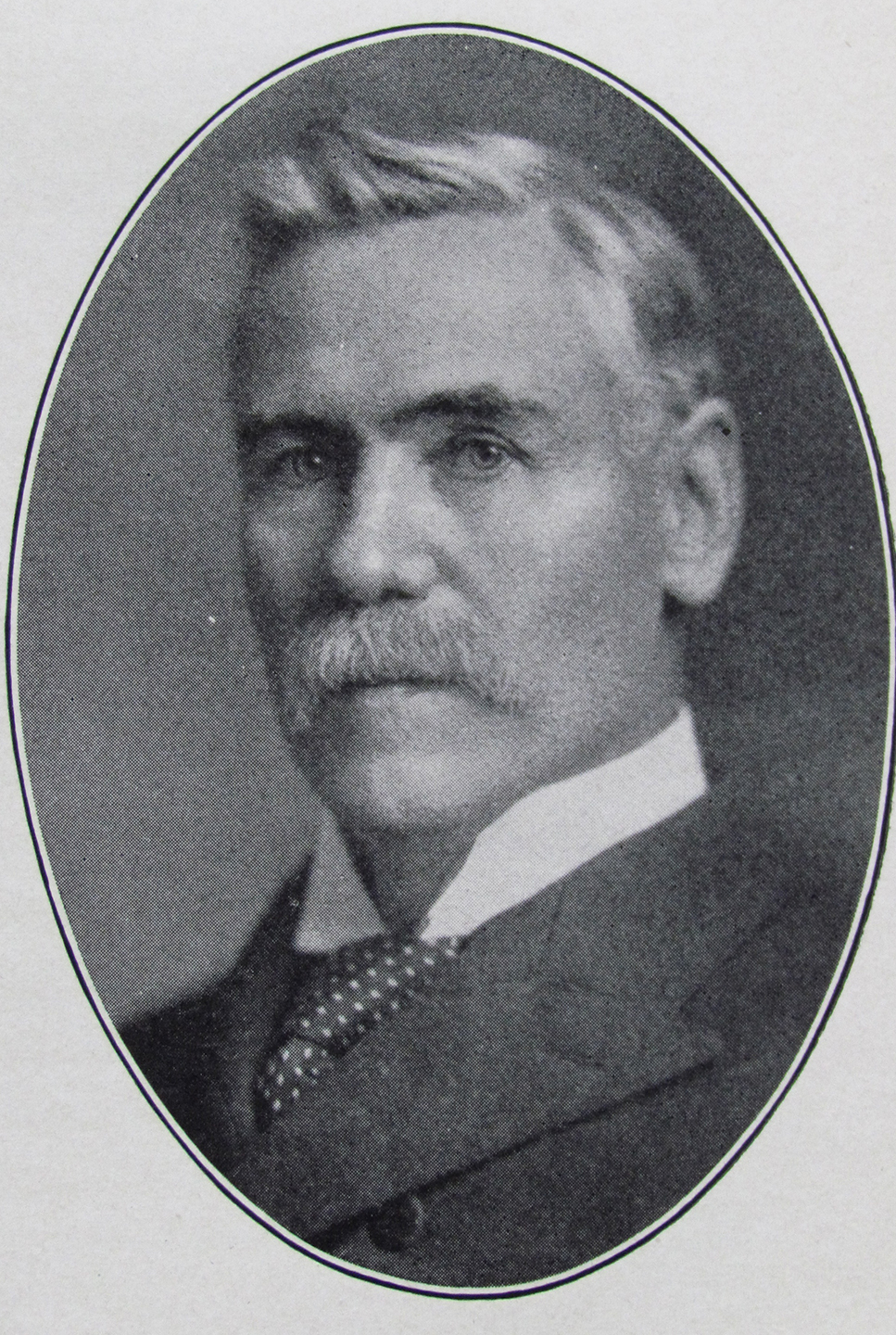
At Cornell his courses in mechanical engineering laboratories were copied by other engineering colleges. In 1882 he wrote a textbook on Experimental Engineering. Carpenter was appointed Professor and Head of the Department of Experimental Engineering in the Sibley College. He is credited by Thurston with important research on frictional losses in steam engines and he later co-authored with Diederichs a text Internal Combustion Engines. Carpenter also had a consulting practice as an expert in patent cases. He was an advisor on a Federal committee on the Panama Canal construction as well as being chosen as a judge of machinery at the World’s Columbian Exposition in Chicago of 1893.
In addition to his teaching, he was an advisor to the Sibley Journal of Engineering. Carpenter had a number of inventions including a coal calorimeter for determining the heating value of coal, a friction-measuring device, as well as an inertial speed governor for steam engines.
Rolla Carpenter had several national leadership positions including vice president of ASME [1908-11], Society of Automotive Engineers [VP 1910-13] and president of the American Society of Heating and Ventilating Engineers in 1908. He was elected into the ASHVE Hall of Fame along with Carrier.
He was honored posthumously by Cornell by the naming of Laboratories in Sibley Hall. His alma mater MSU awarded Carpenter an honorary doctorate LL.D in 1906.
Carpenter was married to Marian Dewey of Michigan in 1876 and they had two sons, George D. and Charles K.
References
Cornell Alumni News Obituary, 1919
American Society of Civil Engineers Obituary
Wikipedia “Rolla C. Carpenter”
The Cornell Daily Sun Vol XXXIX No 19, 20 Jan 1919
East Lansing, Michigan history website
Herman Adkins MacNeil [1866-1947]
Sibley College Instructor [1886-1889]
At the end of the 19th century, there were over three dozen on the teaching staff of Sibley College but only a handful held professorial rank. Nonetheless the instructors and assistant professors provided the backbone of the teaching. One of these was Hermon MacNeil who taught ‘industrial art’ to engineers and perhaps architect students. Drawing and drafting were important aspects of the new engineering curriculum. Photographs of the Sibley freehand drawing room show plaster models of Greek and Roman art as well as other forms used for students to copy. President White had purchased several hundred plaster copies of ancient sculpture for use by students for drawing. Sibley College had a four-year course in industrial art and Hermon MacNeil was an instructor for these courses.
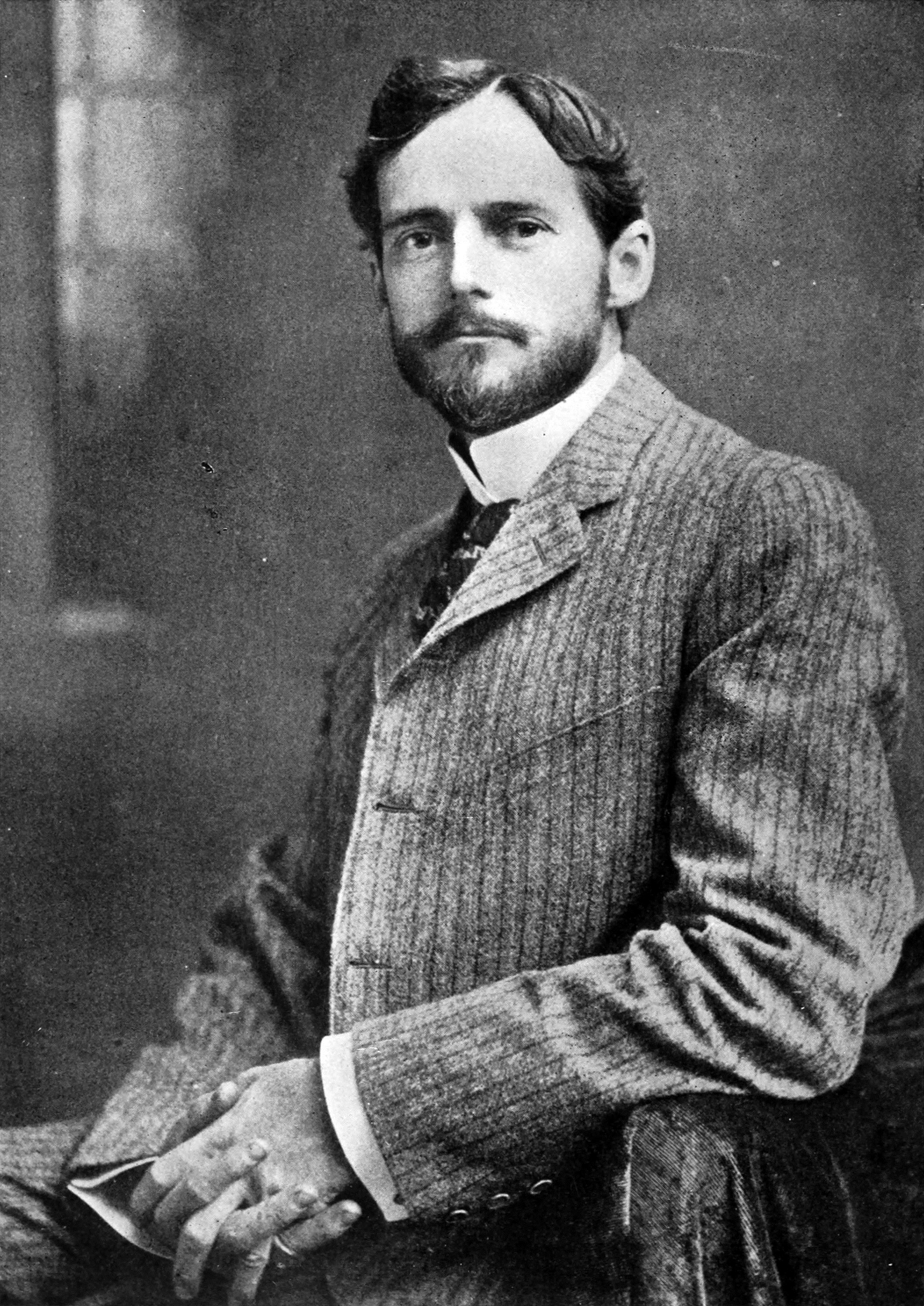
MacNeil was born in Chelsea, Mass in 1866. At Cornell he began to model sculpture in clay and a student Henry Erisman ’92 posed for an athletic sculpture called “Putting the Shot”, which according to Bishop (1962) stood in Sibley College until it disappeared sometime around the turn of the century. Thurston encouraged MacNeil to make a serious study of sculpture and MacNeil went to Paris to study with Henri M. Chapu and then went to Rome for four years.
MacNeil became one of America’s premier Beaux Arts sculptors and president of the National Sculpture Society. Later he was asked to return to Cornell to sculpt the statue of Ezra Cornell that stands in the Arts Quad. He also did a bas-relief bronze of Thurston for ASME headquarters and a copy hangs in the entry way of Thurston Hall. He is also known for his sculptures of Native Americans. His works are in many museums including the Metropolitan Museum of Art in New York.
References
M. Bishop, (1962) A History of Cornell, Cornell University Press, Ithaca, NY
Sibley Journal of Engineering
Wikipedia
John Edson Sweet (1832-1916)
Sibley Faculty [1872-1879]
Sweet was born in Pompey NY, on October 21 1832, the same year as Andrew D White. He obtained his mechanical skills as an apprentice to a carpenter and architect. He later went to London and became a draftsman and learned skills of machine construction that were espoused by England’s great Joseph Whitworth. Returning to upstate New York he became an inventor and manufacturer. He designed his first steam engine in 1872 and was called to serve as head of shops in the newly organized Sibley College of Mechanic Arts at Cornell in the same year. In 1879 he left Cornell to organize a company to manufacture his straight-line steam engine.
Perhaps Sweet’s greatest fame is as one of the founding members of the American Society of Mechanical Engineers in New York City in 1880. Sweet sent out the original letter of invitation to a select number of engineers to organize a rival to the American Society of Civil Engineers or ASCE. At the first meeting of ASME, Robert Thurston, then teaching at Steven’s Institute in Hoboken, New Jersey, was elected the first President of the fledgling professional society. Thurston later was invited by President AD White of Cornell to assume the Director of the Sibley College. Sweet became president of ASME in 1883-84. Sweet in his later years gave public lectures on principles of machine design including one at the Franklin Institute in Philadelphia.
References
AD White “Autobiography”
ASME History Website
Hewett, “A History of Cornell”
1904 Calvert, “History of Mechanical Engineering”
John L. Morris [1832-1905]
First Dean of Sibley College 1870-1885
Sibley Faculty 1868-1903
John Morris was the first professor of mechanic arts and mechanical engineering in the years after the founding of Cornell University. He was a graduate of Union College with a degree in civil engineering and studied with a prominent civil engineer William Gillespie. Before coming to Cornell he worked as an engineer for the NYC Railroad Company.
In the policy struggle between proponents of a shop culture for the Sibley College represented by John Sweet and those with an academic vision for Cornell, Morris was accused by some Sibley graduates as not teaching enough practical knowledge in machine construction. [See Calvert, Chapter 6] Morris outlasted Sweet, who left to establish his own engine company in Syracuse. Morris headed the College of Mechanic Arts until the arrival of Thurston in 1885.
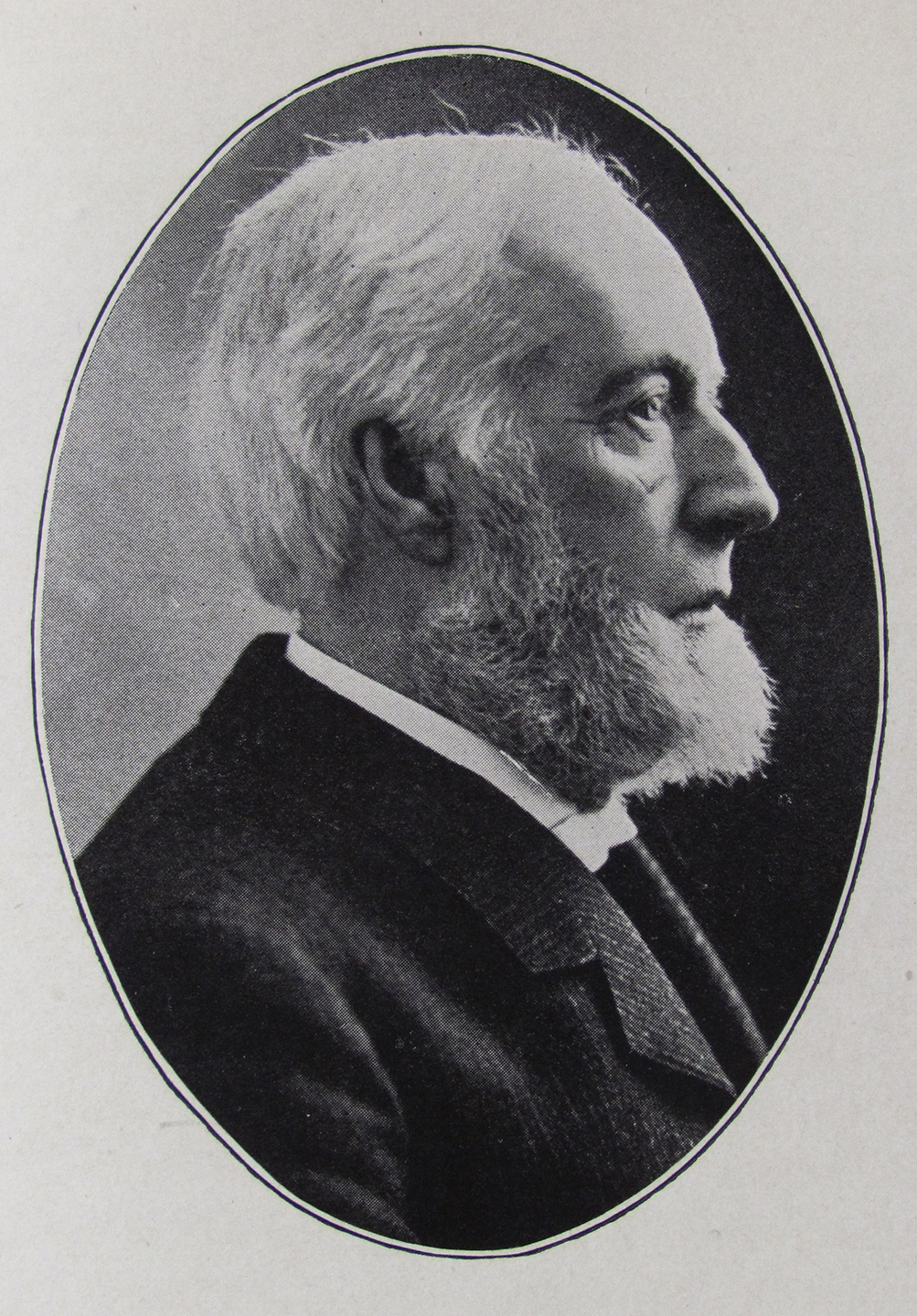
During his tenure at Cornell he taught machine construction and mathematics. President A D White cited Morris as an early builder of the mechanical shops at Cornell. Morris also designed a water power plant for the university. He participated in the design of the early buildings of Cornell particularly West Sibley. At his retirement, the Cornell Alumni News called Morris “a man of positive convictions and warm friendships”
References
Cornell Alumni Magazine
Engineering Quarterly
New York Times Obituary; Online
Dexter S. Kimball [1865-1952]
Sibley Faculty [1898-1903, 1904-1935]
Dexter Kimball served on the Sibley faculty at the beginning of the 20th century right after Thurston died as Director. He was hired by the new Director from Stanford, Albert Smith, to work with John Barr in the subject of machine design. However Kimball’s principal contribution to Cornell engineering was the creation of a program in ‘administration engineering’ or what he liked to call, the economics of production. After Frederick Taylor, Kimball was one of the pioneers of industrial engineering that later morphed into operations research.
Kimball came from a family of millwrights and lumbermen on the Maine-New Brunswick border with Canada. Born in 1865, the charter year of Cornell, his family moved to the lumbering area of Washington State near Puget Sound in 1881 when Dexter was 15. He became an apprentice to a lumber camp machine shop and later worked in San Francisco in the Union Iron Works as a journeyman machinist at the age of 22. He built components for mining hoists and studied at night school to learn drafting.
In 1893, Kimball enrolled at the newly opened Leyland Stanford Junior College and studied mechanical engineering under Professor Albert Smith who a few years later came to Cornell as Sibley College Director. Kimball received an AB in Engineering and went to work for Union Iron Works. He was married in 1898 to Clara Evelyn Woolner and took a job in the mining industry in Anaconda Montana. Worried about the poor environmental living in a mining and smelter town, he accepted an invitation from Cornell to become an assistant professor of machine design in 1898 under the tutelage of John Barr. He also introduced a new course in Design of Heavy Machinery, patterned after his experience in the lumber and mining industry of the West. In 1900 Kimball joined the American Society of Engineers an organization he later served as president. After his three-year contract was up in 1901, there was no higher opening at Cornell and he moved to Massachusetts to work for the Stanley Manufacturing Company as a design engineer.
In 1904 Dexter Kimball received another invitation from Albert Smith for a professorship at Cornell and he returned to Sibley to teach machine design as well as introduce his new course in administrative engineering. He would go on to write a seminal text in this subject “Principles of Industrial Organization” (1913) which by the 1950’s had gone through six editions. Kimball would also co-author a text with John Barr, “Elements of Machine Design” that was a widely used text in engineering. During World War I, in 1916, Kimball headed the US Army program in industrial training as well as a ground school for aviators. He also served as one of the first faculty members on the Board of Trustees and when President Schurmann took a travel leave from Cornell, Kimball was the acting president in 1918, a role he served again in 1929.
With this administrative experience in Kimball’s dossier, and his industrial experience, it is no surprise that in 1920 he was selected by the Trustees as the first Dean of the consolidated Engineering College, merging the colleges of Civil and Mechanical Engineering, creating the three Schools of Civil, Mechanical and Electrical Engineering.
Kimball is credited with recognizing the shift in American manufacturing from an individual shop or craftsman based system, when he was an apprentice, to an industrial, mass production based system before the turn of the new century. However he was not one to establish engineering research programs, as did Robert Thurston. He had over 250 short articles published in his career in technical and popular magazines but they reflected on education and industrial organization rather than on new research-based knowledge. He took on national leadership roles such as the president of the American Society of Mechanical Engineers and served as a consultant to the US Government in Washington when Herbert Hoover was there. [They were both classmates at Stanford.] Although these positions served to keep Cornell and the Sibley School visible in the national picture in engineering, Kimball recognized at the end of his career, in his autobiography “I Remember” (1953), that by the 1930’s, Cornell engineering had slipped considerably through lack of investment and new competition from State supported institutions. This malaise at Cornell would not be fixed until after World War II and the Deanship of Hollister.
References
D.S. Kimball (1953) “As I Remember”
Donald Berth, Gladys J. McConkey, “Capstones of Century I”, Engineering Quarterly, Vol 6, (No 3) Autumn 1971
William F. Durand [1859-1958]
Sibley Faculty [1891-1904]
William Durand was born in the age of wind-powered ships and finished his career as one of the second-generation pioneers of aviation. He was born in Connecticut, and obtained his engineering training at the US Naval Academy. He served the US Navy at a time when naval ships were switching to steam power. He graduated as a cadet engineer and after spending two years on the USS Tennessee, he became an assistant engineer and was assigned to the US Navy Bureau of Steam Engineering. While teaching at Lafayette College in Easton PA, he earned a PhD. He was then assigned as a Navy instructor at Worchester Polytechnique in 1887 and subsequently took a civilian position at Michigan State College and helped create a department of mechanical engineering.
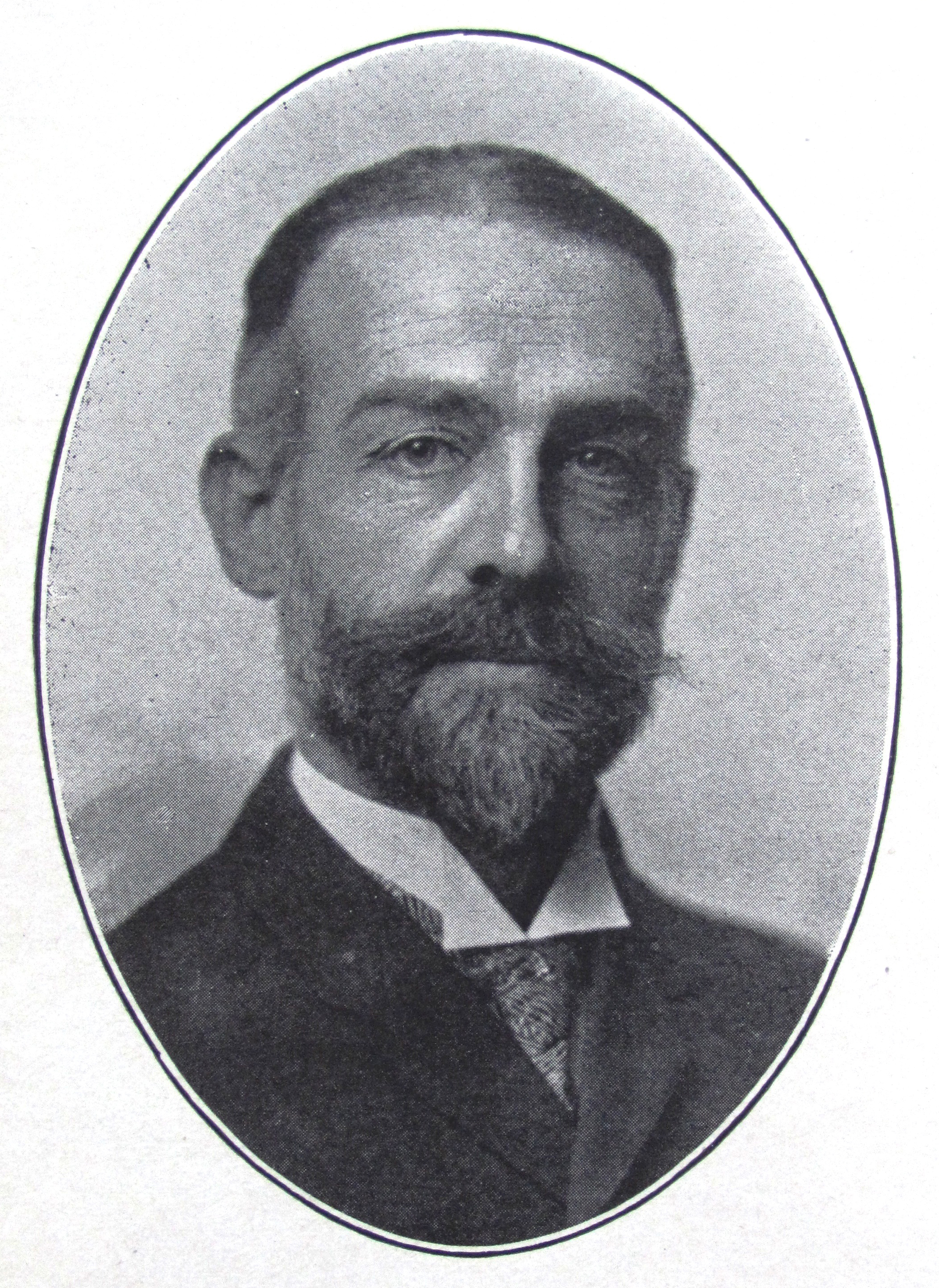
Robert Thurston, Director of the Sibley College had also taught at the US Naval Academy and likely followed the career of Durand. In 1891, he invited Durand to head a program at Cornell in Naval and Marine Engineering. Durand conducted research on the fluid mechanics of ship’s propellers at Sibley. He tested 49, 12-inch propellers in the hydraulics laboratory. He also patented a radial planimeter for averaging data in polar coordinates. In 1903, Thurston died unexpectedly and Durand was in line to become Director as he was serving as acting Director. Instead, the Trustees and President chose a former Sibley graduate, Professor Albert W. Smith of Stanford as the new Director. Durand was then recruited by Stanford to replace Smith as head of mechanical engineering.
Oddly in spite of the fact that early aviation progress was centered on the East Coast and Europe, Durand developed one of the first courses in aviation and switched his research to the study of aircraft propellers. As a result of this activity, when the US Government created the NACA or National Advisory Committee on Aeronautics, in 1914, Durand was appointed the only civilian member and became its Chair in 1915. In 1917 he was elected one of the first engineers to become a member of the National Academy of Science. In 1917 he advised the Army to develop turbochargers for aircraft engines to increase their performance and recommended a Sibley graduate, Sanford A. Moss of General Electric, to head up this program. Durand had remembered that Moss had worked on gas turbochargers at Cornell around 1897.
Following in Thurston’s footsteps, Durand became the president of the ASME in 1924 and was awarded the ASME Medal in 1945.
Durand retired as Professor Emeritus from Stanford in 1924 at age 65, but continued serving as an advisor to the government through World War II. In his retirement he helped edit a 25-volume encyclopedia on fluid mechanics. One of the authors was Theodore von Karman of Cal Tech who would recommend William Sears as director of the Cornell Aeronautical Laboratory in 1946 and would become a visitor and guest lecturer at Cornell in later years. One wonders what would have become of aviation education and research at Cornell if Durand had been chosen as Sibley Director instead of Smith.
References
Donald Berth and Gladys McConkey, Engineering Cornell Quarterly, 1971
Stanford Faculty Obituary
Wikipedia article on William F. Durand
Leroy Grumman [1895-1942]
Sibley Student [1912-1916]
Leroy Grumman was born in Huntington on Long Island NY. He graduated from high school in 1911 with dreams of aviation. He was probably inspired by the world famous Belmont airshow east of New York City in which all the world’s pilots competed including upstate New York’s Glenn Curtiss. Grumman enrolled in Cornell’s Sibley College where he earned a BS in mechanical engineering. With the US entry in World War I Grumman joined the Navy Reserve as a machinist’s mate and took training in at Columbia University in sub chaser engines. He was sent to Pensacola Florida to receive flight training. After a tour of duty he was sent to MIT to study aeronautical engineering. He was assigned as a test pilot for Curtiss built Navy flying ‘boats’. In 1919 he then became a project engineer for Loening Aeronautical Engineering Corp. in NY. In 1920 became a test pilot for Loening amphibian aircraft, eventually becoming general manager.
When Loening was sold to Keystone Aircraft in 1930, Grumman and other Loening employees decided to form their own company. One of the first projects for the new company was to build aircraft with retractable landing gear for the US Navy in which Grumman was awarded a patent (1,859624). By 1943 the company had grown from 250 to 25,000 employees.
In 1953 Leroy Grumman was elected to the Cornell Board of Trustees. He donated money for a new squash court as well as a building for the new School of Aeronautical Engineering that bears his name. Today this building is sandwiched between East Upson and Rhodes Hall.
References
Wikipedia
Albert W. Smith [1856 ,1942]
Sibley Graduate 1879, Faculty [1904-1921]
Sibley Director [1904-1921]
Acting Cornell President 1920
Albert Smith is an example of the close relationship between Cornell and Stanford Universities. Smith received an advanced degree from Sibley College in 1879, before the Thurston era and worked in industry for some time. He also headed the mechanics laboratory at Sibley for a time. In 1891, Leland Stanford, out of grief for the loss of his only son, founded Stanford University. Smith was hired to create a curriculum in mechanical engineering and specifically in machine design. In 1904 after the untimely death of Thurston, Smith was called to Cornell to serve as Director of the Sibley College, then one of the largest programs in mechanical engineering in the country. His appointment bypassed Durand, then acting Director at Cornell, who then went to Stanford to replace Smith. Smith hired Dexter Kimball to teach at Cornell in machine design. Kimball had obtained one of the first Stanford engineering degrees under Albert Smith.
Albert Smith served as Director from 1904-1921 until his retirement. He hired a number of key faculty members during his tenure. The principal areas of faculty expertise during this time were machine design and heat power engineering along with internal combustion engines. Oddly in spite of the fact that the Army had established a ground school for aviation at Cornell in 1917 and the Curtiss aeronautical factories were a short distance away as well as the Thomas brothers’ airplane factory in Ithaca, there was no attempt during Smith’s tenure to establish a program in aeronautical engineering. Durand on the other hand created a course in aeronautics at Stanford when he arrived switching his research from naval to aviation engineering. Smith also served as acting President of Cornell.
When Smith retired, he was replaced by Herman Diederichs as Director, who served from 1921-1935 until he became Dean of Engineering, succeeding Kimball. This period was one of decline in engineering at Cornell. In 1911 the combined engineering enrollment in civil and mechanical engineering, including electrical, was 1745, whereas by 1935 it had declined to 789. Probably the Depression contributed to this decline but during this same period US engineering school enrollment went from 13,000 to 70,000. [Berth, 1971]
Kate Gleason [1865-1933]
Sibley Student [1884, 1888]
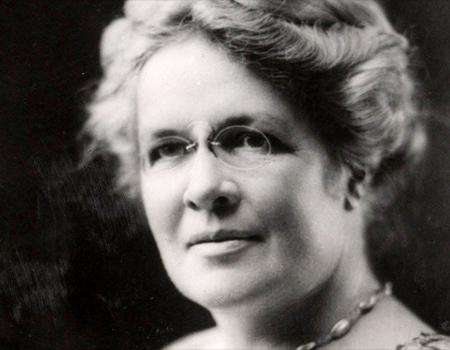
In the Cornell University’s charter year, 1865, Catherine [Kate] Gleason was born to Irish American parents in Rochester NY. Her father started a manufacturing shop making gears and by the time she was a teenager, she was working in the family business. In 1884 and 1888, Kate Gleason was the first woman mechanical engineering student in the Sibley College of Mechanical Engineering and Mechanic Arts, taking special courses to help her family business. In 1890 she was treasurer of Gleason Gear Works. Later in 1918 she was the President of First National Bank of Rochester. She was elected the first woman member of ASME in 1917. The ASME Kate Gleason Award is named in her honor. Kate was a strong supporter of women’s suffrage. [See ‘winningthevote.org’ for more information.] The Rochester Institute of Technology engineering college is named in her honor.
Clarence W. Spicer [18xx-1939]
Sibley Student [1899-1903]
Almost a century ago another Sibley student, Clarence W. Spicer, was working on a design project to build a motorcar. In 1903 he filed a patent to replace chain drives in automobiles with a universal joint in the drive train, a mechanism that exists in most automobiles today. In 1904, he started the Spicer Manufacturing Co, later called Dana Corporation that still exists. He was elected to the Automotive Hall of Fame. Today Cornell automobile project team members follow in Spicer’s tradition. [See ‘spicerparts.com/heritage’ for more information]
Reference
Wikipedia
Dana Corp History website
Lionel Simeon Marks [1871-1955]
Sibley Masters Student [M.M.E. 1894]
Marks was born in Birmingham England and earned a BS degree in science at what is now the University of Birmingham. In the 1890’s he received a fellowship to study mechanical engineering at the Cornell Sibley College of Mechanical Engineering. In 1906 he married Josephine Peabody an American Poet. He became a professor of mechanical engineering at Harvard and eventually became a Professor at MIT.
In 1922 he wrote a book “The Airplane Engine”. He is well known for his editorship of the often-cited Marks Standard Mechanical Engineering Handbook first published in 1916 that has undergone more than eleven editions comprising 160 contributors and 1800 pages. In the third edition in 1930 it had sold over 100,000 copies.
It should be noted that Marks reviewed the book of Cornell professor of physics Frederick Bedell MS’91, The Airplane in 1920 for the journal Science, a year before his own book The Aircraft Engine was published as reported in Cornell Alumni News of 1920.
During WWI Marks worked on a project to study aircraft engine design sponsored by the National Aeronautics Advisory Committee (NACA) chaired by another Cornell Sibley faculty alumnus William Durand.
James Norman Goodier [1905-1969]
Sibley Faculty [1938-1847]
After Robert Thurston, the principal star of mechanics in the Sibley School was James Norman Goodier [1905-1969]. Goodier had studied at Cambridge and then came to the University of Michigan to study the theory of elasticity under the Ukrainian master Stephen P Timoshenko from 1929-1931. Goodier received a joint PhD from University of Michigan and Cambridge University in 1931. He then worked for seven years in Canada as a research fellow at the Ontario Research Foundation. In 1931 he married Timoshenko’s daughter Mariana. They had three children.
Goodier came to Cornell in 1938 as Professor of Applied Mechanics. He became Head of the Department of Applied Mechanics in the Sibley School. Unfortunately after WWII he left for Stanford in 1947. One of his students at Cornell was George Carrier (PhD 1944) who later became a distinguished faculty at Harvard and member of the National Academy of Engineering.
Following an earlier exodus of Cornellians to Stanford, Goodier headed the Division of Engineering Mechanics from 1954-1965. His mentor Timoshenko had also left the East Coast for Stanford and they co-authored a popular textbook on the Theory of Elasticity in 1951.
Goodier became a Fellow of ASME and was awarded the ASME Timoshenko medal in 1961, one of ASME’s highest awards. [Goodier’s Cornell student, George Carrier would win the medal in 1978. Professor John Lumley of the Sibley School also won the Timoshenko medal in the 1990’s.] Another node in the Goodier network is a Cornell Sibley alumnus Professor Paul Naghdi [1924-94] formerly of UC Berkeley, who was also awarded the Timoshenko Medal in 1980. In his acceptance speech Naghdi mentioned attending Goodier’s graduate course at Cornell and being inspired to go to graduate school and study solid mechanics.
In Goodier’s obituary, his Stanford colleagues recalled his shy humor and British wit. He loved poetry and literature and played the piano.
There is an apocryphal story that Goodier left Cornell for Stanford because his wife Mariana wanted to live near her famous father Stephen Timoshenko in Palo Alto. However Bill Sears in his memoirs said that Goodier left because he didn’t like heading up two departments, Applied Mechanics and Machine Design and was reluctant to complain to Dean Hollister. Oddly he eventually headed a similar department at Stanford after he was there for seven years.
Sears overlapped with Goodier for one year 1946-47 but became good friends. Both were a new breed of engineer who had a love for and skills in applied mathematics as an important tool in solving problems in engineering mechanics. One graduate student who came to work with Goodier in 1946 was disappointed that the professor was leaving. Goodier told him he should switch majors and work with Bill Sears in the Aero School. That student was Franklin Moore, who Sears later said was a brilliant student. Moore eventually returned to Cornell after his PhD and was elected to the National Academy of Engineering.
James Goodier was in the vanguard of a procession of Cornell professors of mechanics from the British Isles who would were also expert in applied mathematics. Following Goodier was H. Don Conway, another elasticity expert who joined T&AM in the late 1940’s, and Hal Mitchell from Ireland who taught both elasticity and space dynamics in the 1960’s. Geoffrey Ludford came around 1960 with expertise in theoretical fluid mechanics and methods of applied mathematics. Later in the 1970’s Phillip Holmes would hop over the ‘pond’ and join T&AM and introduce the Cornell community to chaos theory and nonlinear dynamics.
References
Stanford Obituary [EH Lee et al]
ASME Timoshenko Medal acceptance speech of Paul Naghdi 1980
William R. Sears (1994) Stories from a 20th Century Life, Parabolic Press, Stanford, California.
William R. Sears [1913-2002]
Cornell Professor [1946-1974]
Director Graduate School of Aeronautical Engineering [1946-1963]
Director Applied Mathematics Center [1962-1974]
William Sears was born in Minneapolis and at age 21 graduated from the University of Minnesota with a BS degree in aeronautical engineering. He did his graduate training at Cal Tech under the guidance of Theodore von Karman. During this time he also obtained his pilot’s license. After finishing his PhD he was an instructor in 1939 and then assistant professor at Cal Tech. Through the friendship of von Karman with Jack Northrop, Sears became chief of aeronautics and flight-testing at Northrop Aviation during the war years. He worked on the P-61 or Black Widow as leader of the design team, as well as on the flying wing aircraft.
After WWII Sears was part of a team headed by von Karman to go to Germany to interview German experts in aeronautical technology. When Dean Hollister of Cornell invited von Karman to come and head a new aeronautical engineering program, von Karman recommended Sears who in 1946 accepted the offer and came to Ithaca as Director of the Graduate School of Aeronautical Engineering or GSAE. He assembled a team of both professors and graduate students many of whom had experience during WWII. Although Sears’ expertise and interest was principally in aeronautics, in the early years GSAE had courses in aircraft design including structures and flight dynamics. Sears hired Arthur Kantrowitz as well as Edwin Resler who later became Director of GSAE and in 1972 Director of the School of Mechanical and Aerospace Engineering [MAE].
After the war, the Curtiss-Wright Corporation no longer had use of a large research facility in Buffalo and offered the Laboratory to Cornell University. Although some had hoped that Sears would center his Graduate School at Buffalo, he resisted and instead opted for a consultant role of GSAE in Ithaca to the Cornell Aero Laboratory (CAL) in Buffalo. GSAE received funds, from CAL to support graduate students, in return.
Sears, known to his friends as ‘Bill’ hired a young woman, ‘Toni’ Anthony, out of Keuka College as secretary and administrator and she became an important contributor to both GSAE and the Sibley School until she retired in 1992. Toni, in a recent interview said the GSAE was like a close family at the time and even had its own flying club as many faculty and students, including Sears were pilots.
Sears invited Theodore von Karman to come to Cornell many times, once as a Cornell Messenger Lecturer in the 1960’s.
Bill Sears’ interests in the early years were on aerodynamics and fluid dynamics including boundary layer theory, wing theory and internal flows in turbo-machinery. In the early 1960’s, he taught an introductory graduate course on Incompressible Fluid Dynamics using a plastic binder textbook that he had written. The course was very theoretical and used advanced mathematics called Complex Variables. The Author and future director Sid Leibovich were students in this class c. 1962. The students dreaded Sears’ Saturday morning recitation class in Grumman Hall in which he would randomly call students to the board to solve homework problems from his book.
Sears later became interested in fluid flow in magnetic fields. He and his colleagues often went to the Cornell Aero Lab in Buffalo to consult and give lectures. However by the 1960’s interest in aeronautical design of subsonic flight vehicles had shifted to supersonic flow around rockets and space vehicle reentry. GSAE research became refocused on applied physics and developed a close relationship with the Engineering Physics Department at Cornell. One of Sears’ early students was Franklin Moore, who then assumed a position as head of the aeronautics department at Cornell Aero Lab. Moore returned as Professor in the Sibley School.
GSAE faculty who came into the merged MAE School in 1972 were Edwin Resler, Albert George, Tobias de Boer, and Shan Fu Shen.
In 1963, Sears resigned as Director of the Aero School and became the first Director of Cornell’s Applied Mathematics Center. In 1974 however, Bill accepted a position at the University of Arizona. He returned to Cornell often to attend the Cornell sponsored ‘Sears” Lecture, sometimes flying his own plane across country. While at Cornell he was an avid musician and played in a recorder ensemble. He continued both his flying and musical interests at Arizona. He became Emeritus Professor at Arizona in 1978. He wrote an informal autobiography, which has many anecdotal stories about life at Cornell in the 1940’s though the 1960’s.
Bill was an elected member of the both the National Academy of Sciences and National Academy of Engineering.
References
AIAA Journal “Professor William R. Sears, a Short Biography
Wikipedia
Interview with Alice ‘Toni’ Anthony
F. K. Moore AIAA History of Cornell Aeronautical Engineering
William R. Sears (1994) Stories from a 20th Century Life, Parabolic Press, Stanford, California.
Wanda Szemplinska-Stupnicka [1933-2014]
T&AM Faculty [1980-1981]
During the Cold War in 1981, Professor Wanda Szemplinska-Stupnicka was the first senior woman visiting professor in the College teaching dynamics in the Department of Theoretical and Applied Mechanics, now part of the Sibley School. She was a member of the Polish Academy of Sciences. As a student in Poland she became a famous glider pilot, setting records and flying over the Alps. In a visit to India, Wanda even took the prime minister of India on a flight to the astonishment of the Indian Government officials. Wanda returned to Poland in 1983 and wrote several books on dynamics and “Chaos Theory”. We were sad to learn that she passed away in March 2014 at the age of 81.
Reference
Personal recollections FC Moon
G. David Low
Sibley Student [1975-1980], NASA Astronaut [1990, 1991, 1993]
Finally we have a story of Ezra Cornell’s socks. Around the same time as Wanda Szemplinka’s tenure at Cornell, G. David Low graduated from mechanical engineering in 1980. David became Cornell’s first astronaut and flew on three Shuttle missions STS-32 [1990], STS-43 [1991] and STS-57 [1993]. On his first NASA flight into space, he took a pair of Ezra Cornell’s socks with him. These ‘space socks’ are in the Cornell archives. Cornell undergraduates follow in David’s footsteps by designing their own satellite that has gone into space orbit and several dozen Cornellians have been hired by the aerospace company Space-X in recent years and are designing the next shuttle spaceships.
References
Personal recollections
FC Moon Wikipedia


